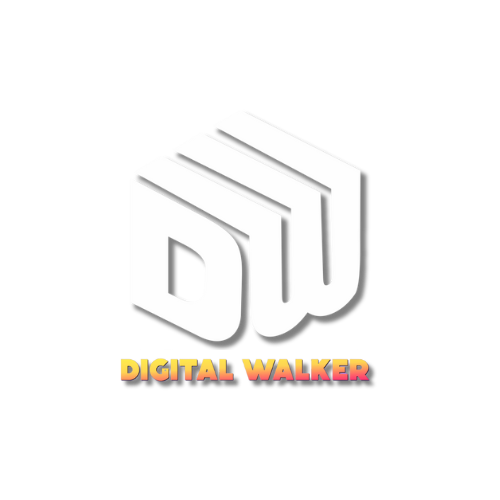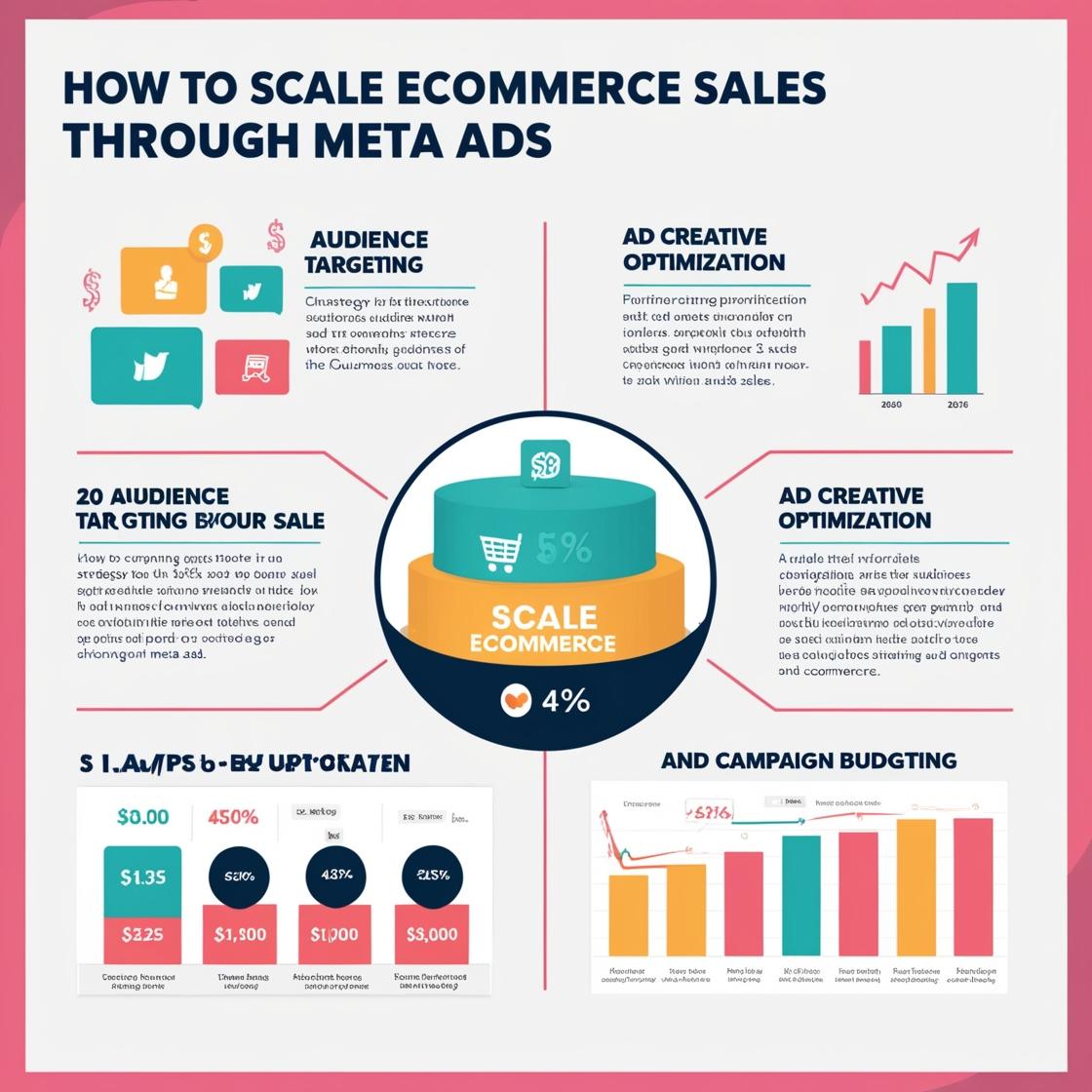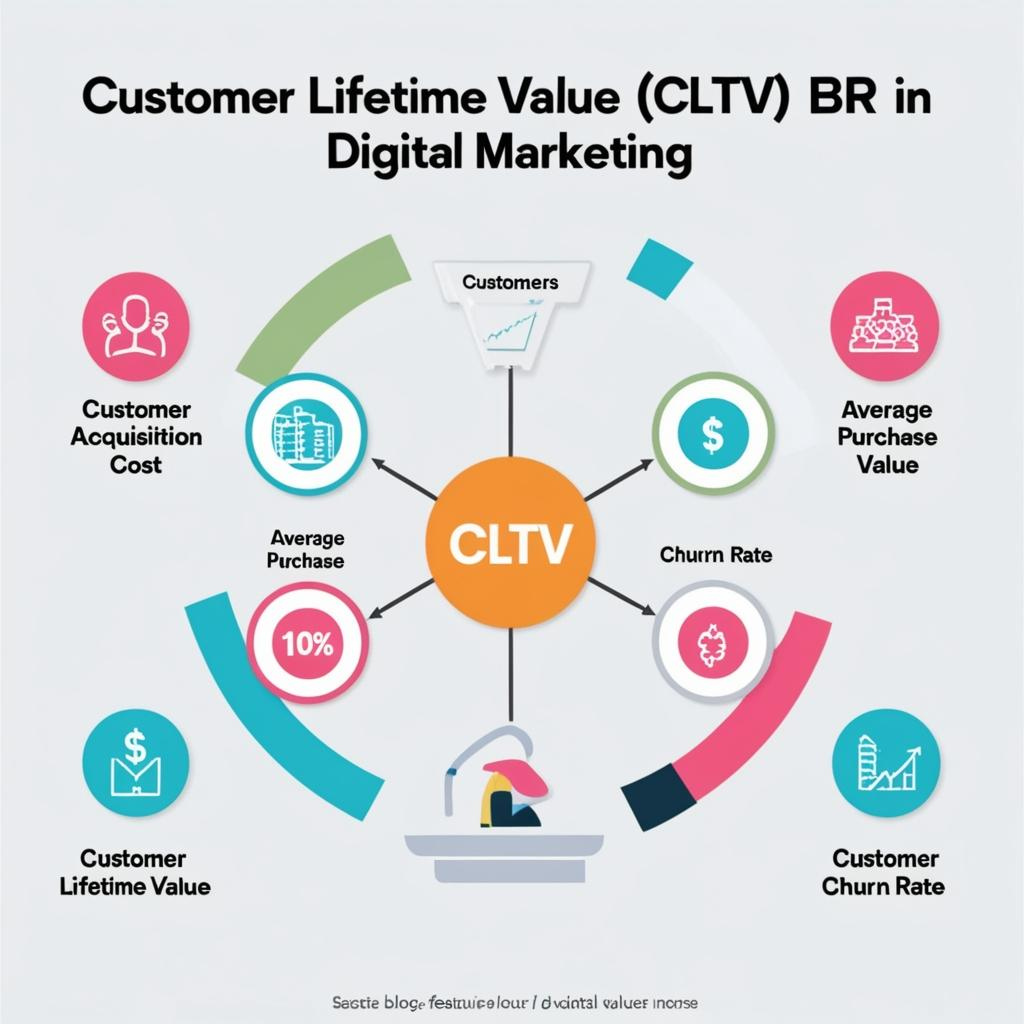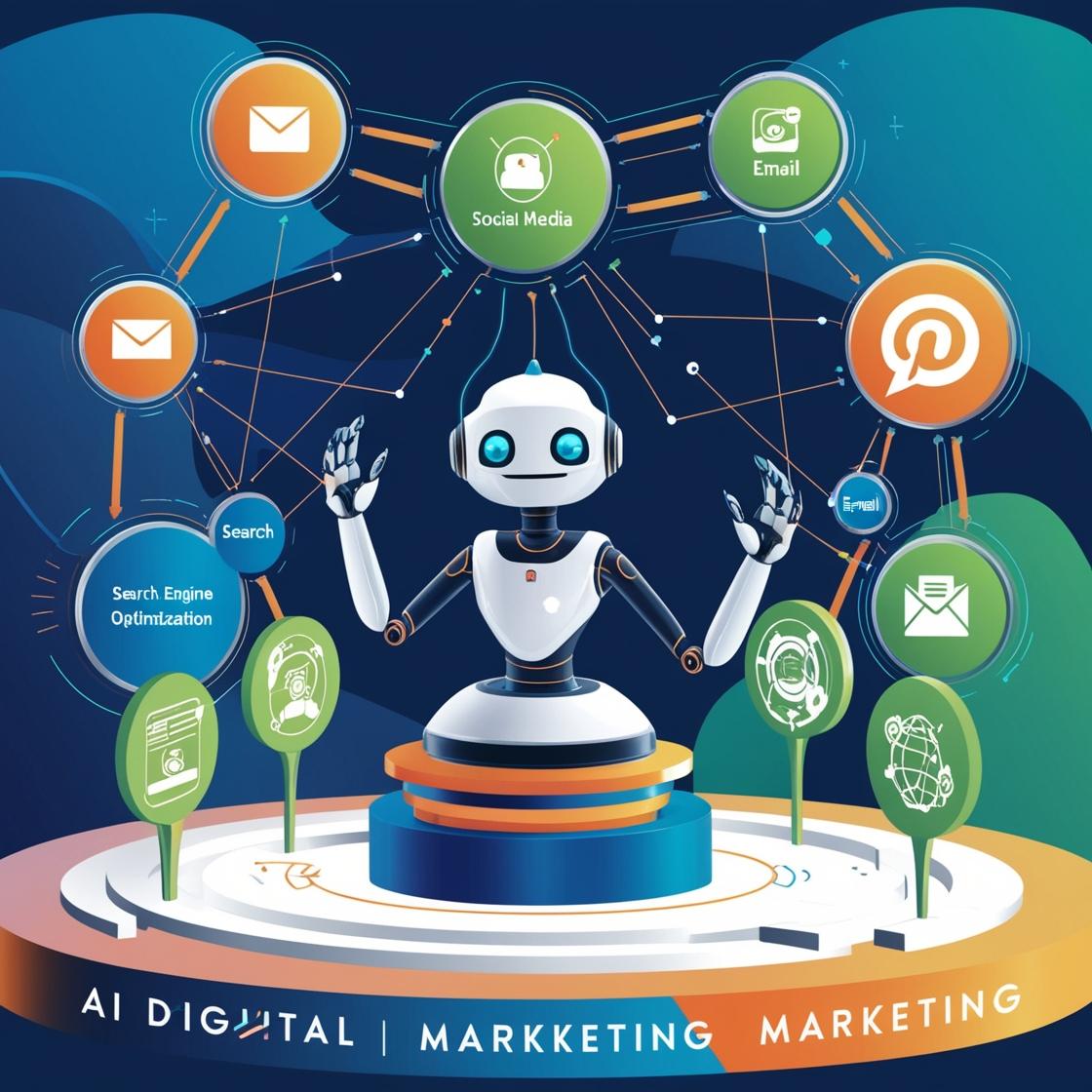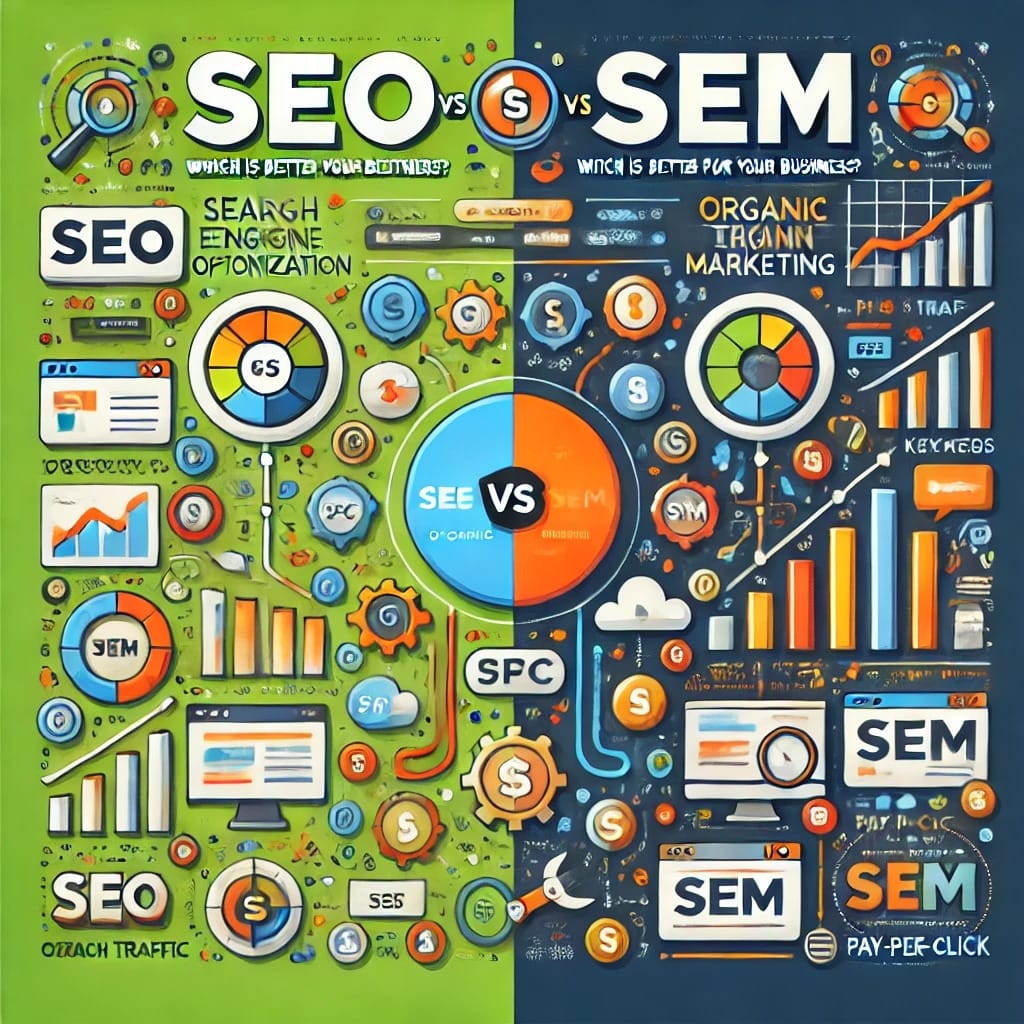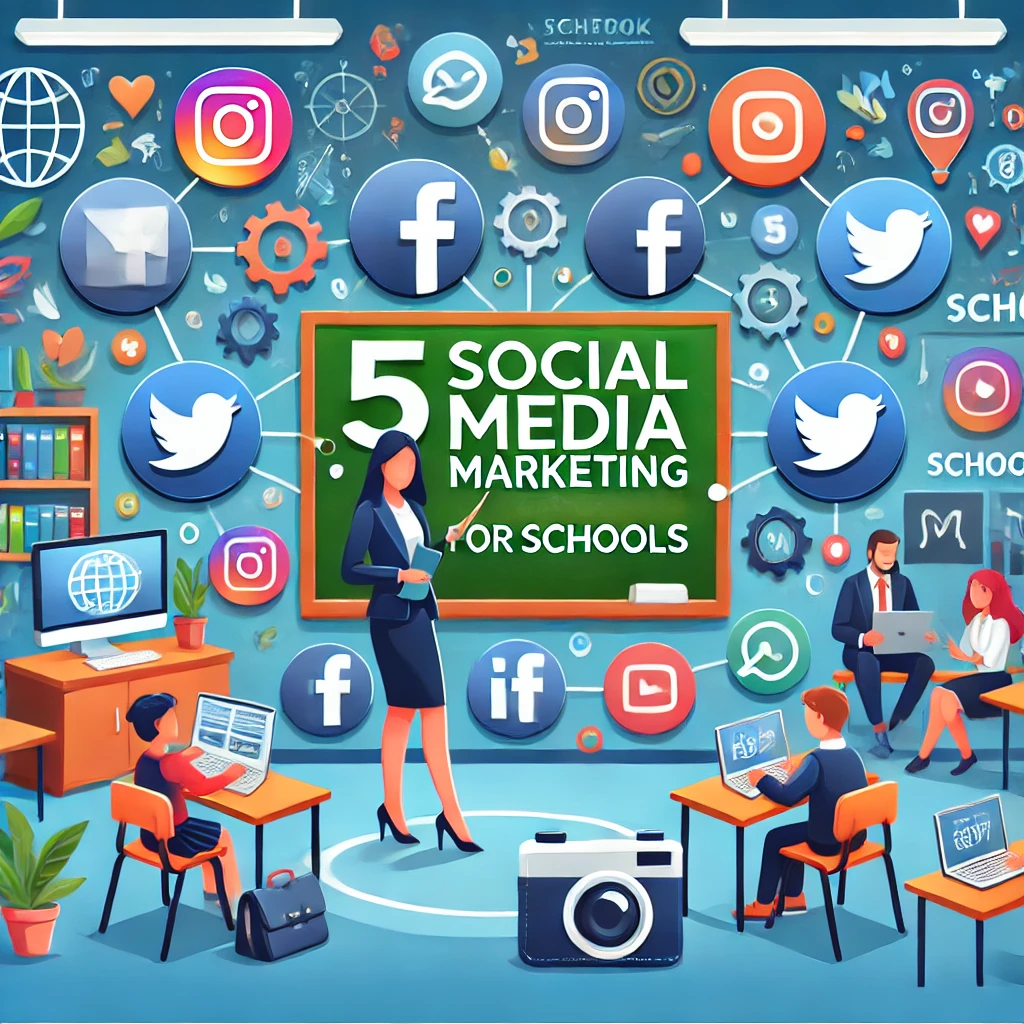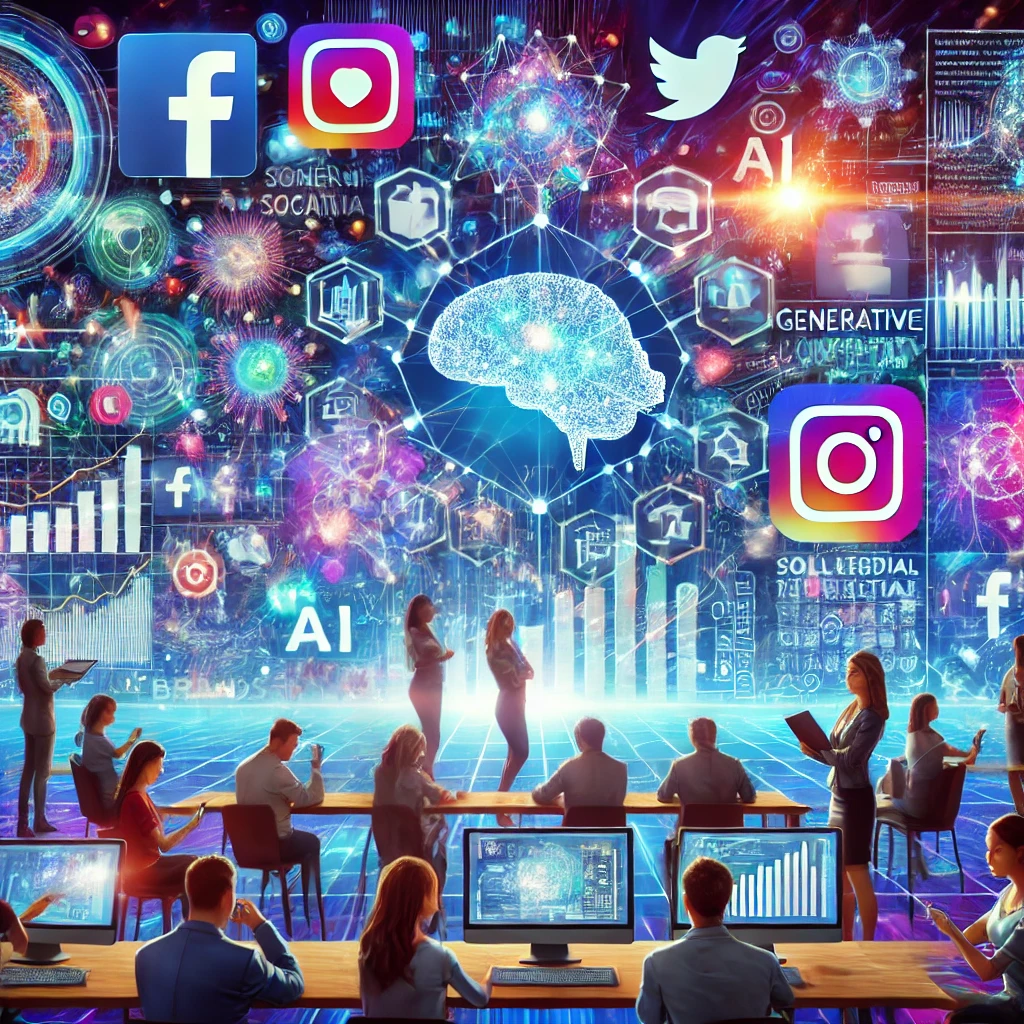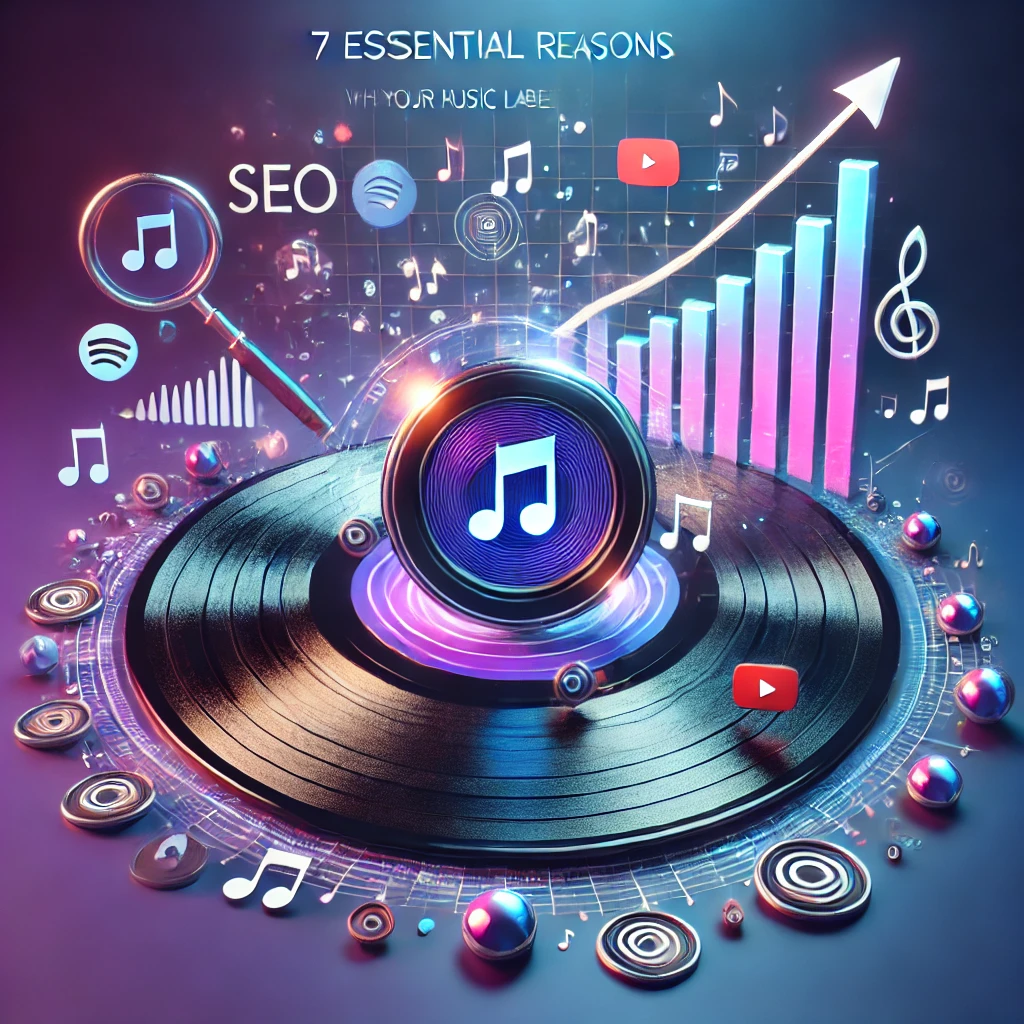How to Scale Ecommerce Sales Through Meta Ads? A Guide to High-ROI Performance Marketing
Introduction
In today’s fast-paced digital world, e-commerce brands are flourishing, but only those with a strategic edge are truly scaling. If you’re wondering how to scale ecommerce sales through Meta ads, you’re already on the right path. Meta (formerly Facebook) offers some of the most powerful tools in the advertising ecosystem — perfect for e-commerce businesses aiming to maximize their return on ad spend (ROAS) and expand their customer base efficiently.
In this guide, we’ll walk you through high-ROI performance marketing tactics using Meta ads, the role of a well-structured ad strategy, and how partnering with an expert e-commerce performance marketing agency in Delhi can supercharge your growth.
For readers who want to explore Meta ads setup, campaign structure, and policies.
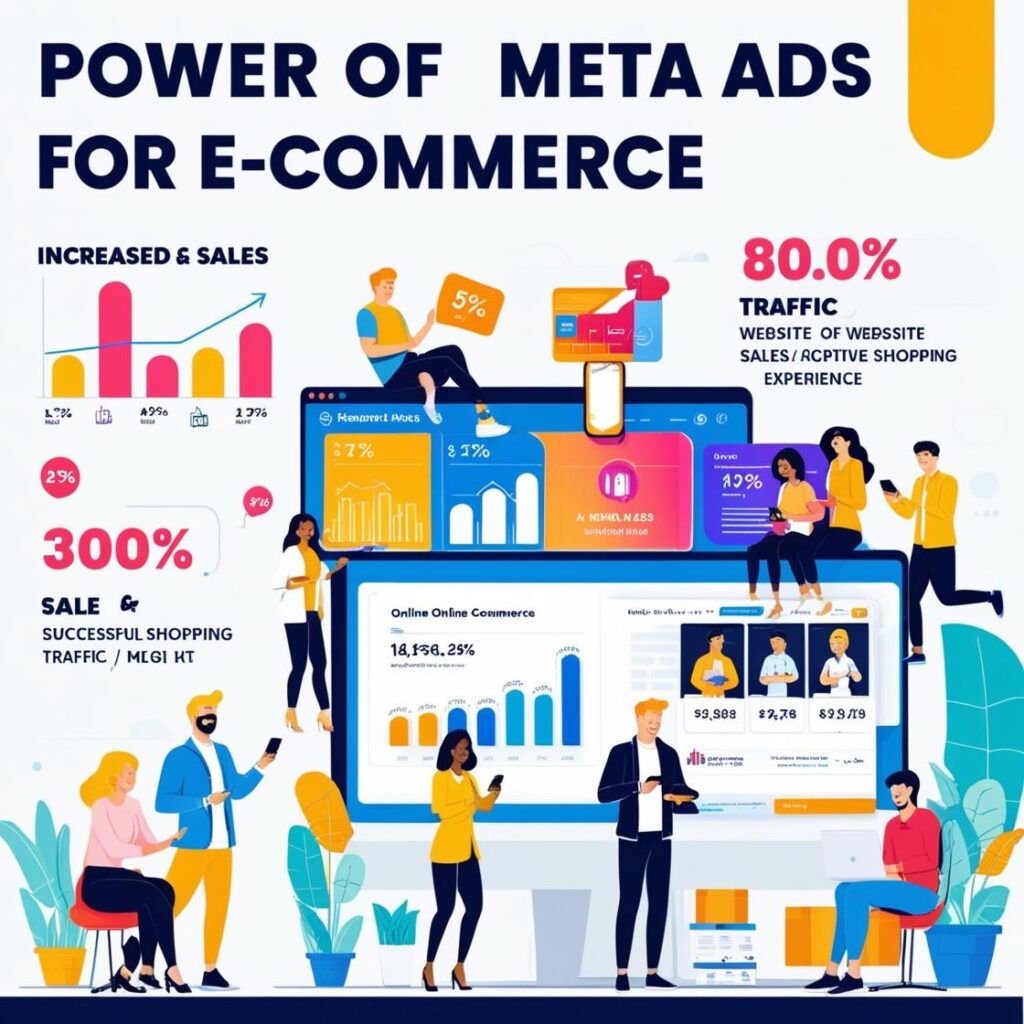
Understanding the Power of Meta Ads for E-commerce
Meta Ads, encompassing both Facebook and Instagram platforms, give e-commerce businesses access to billions of users. But the true power lies not just in the reach — it’s in the precision. From behavior-based targeting to lookalike audiences, Meta offers an unrivaled toolkit to drive conversions.
If your goal is how to scale ecommerce sales through Meta ads, it starts with recognizing the unique advantages Meta brings to the table:
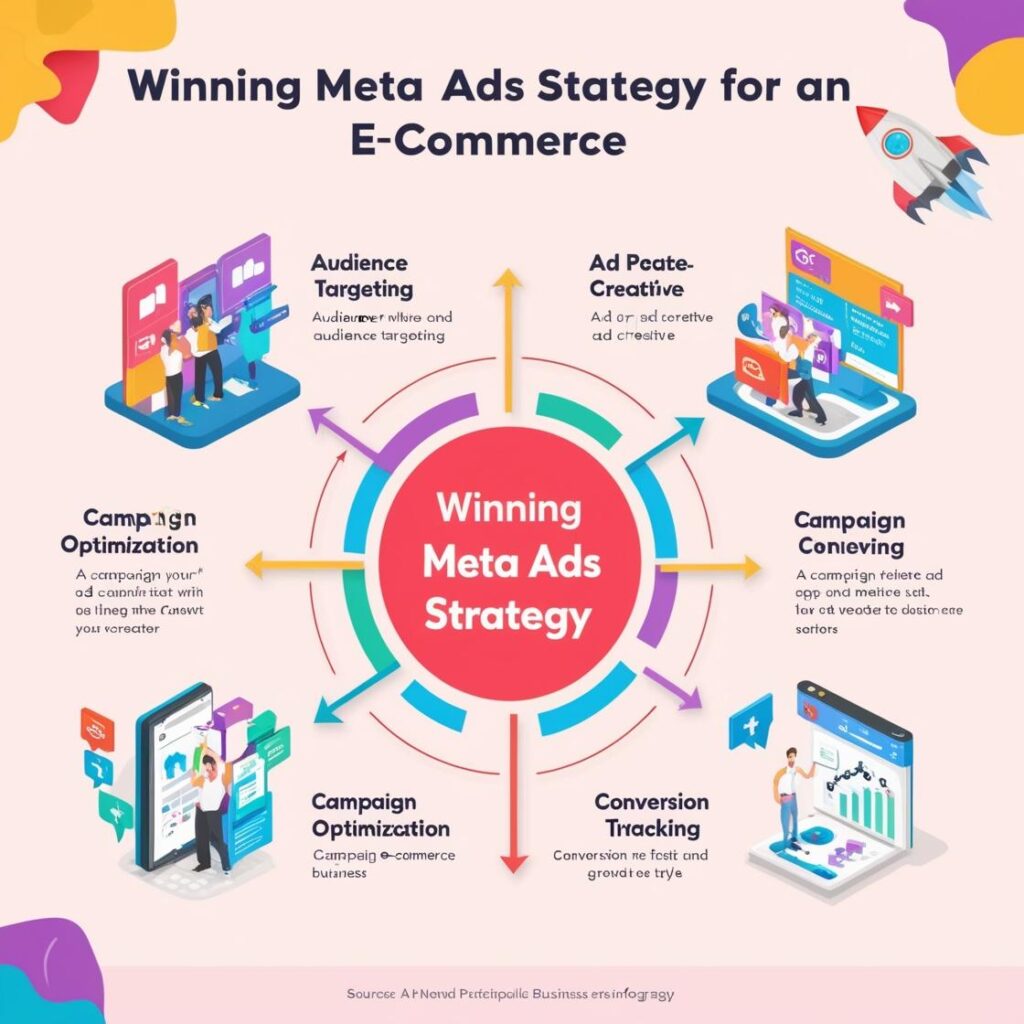
Crafting a Winning Meta Ads Strategy for E-commerce Business
Creating a strong Meta ads strategy for ecommerce business involves more than just boosting posts. You need a full-funnel approach that guides users from discovery to purchase and then turns them into repeat buyers.
Step 1 – Know Your Customer (Audience Research)
Before spending a single rupee on ads, build deep customer personas. Use Meta’s Audience Insights tool and analyze your existing customer data to understand demographics, interests, and online behavior.
Key Tip: Create Custom Audiences for warm leads and Lookalike Audiences to scale cold traffic.
Step 2 – Build a Full-Funnel Campaign Structure
Split your campaigns into 3 stages:
- Top of Funnel (TOFU): Brand awareness, video views, and engagement campaigns.
- Middle of Funnel (MOFU): Retargeting website visitors, add-to-cart users, and Instagram profile visitors.
- Bottom of Funnel (BOFU): Conversion-focused campaigns targeting purchase-intent users.
This structure ensures that you’re guiding users through the buyer’s journey, not just bombarding them with sales pitches.
Step 3 – Optimize Creatives for Performance
Creatives make or break your campaign. Use high-quality images, compelling headlines, and clear CTAs. A/B test different formats — carousels, videos, reels, and UGC (user-generated content) to see what performs best.
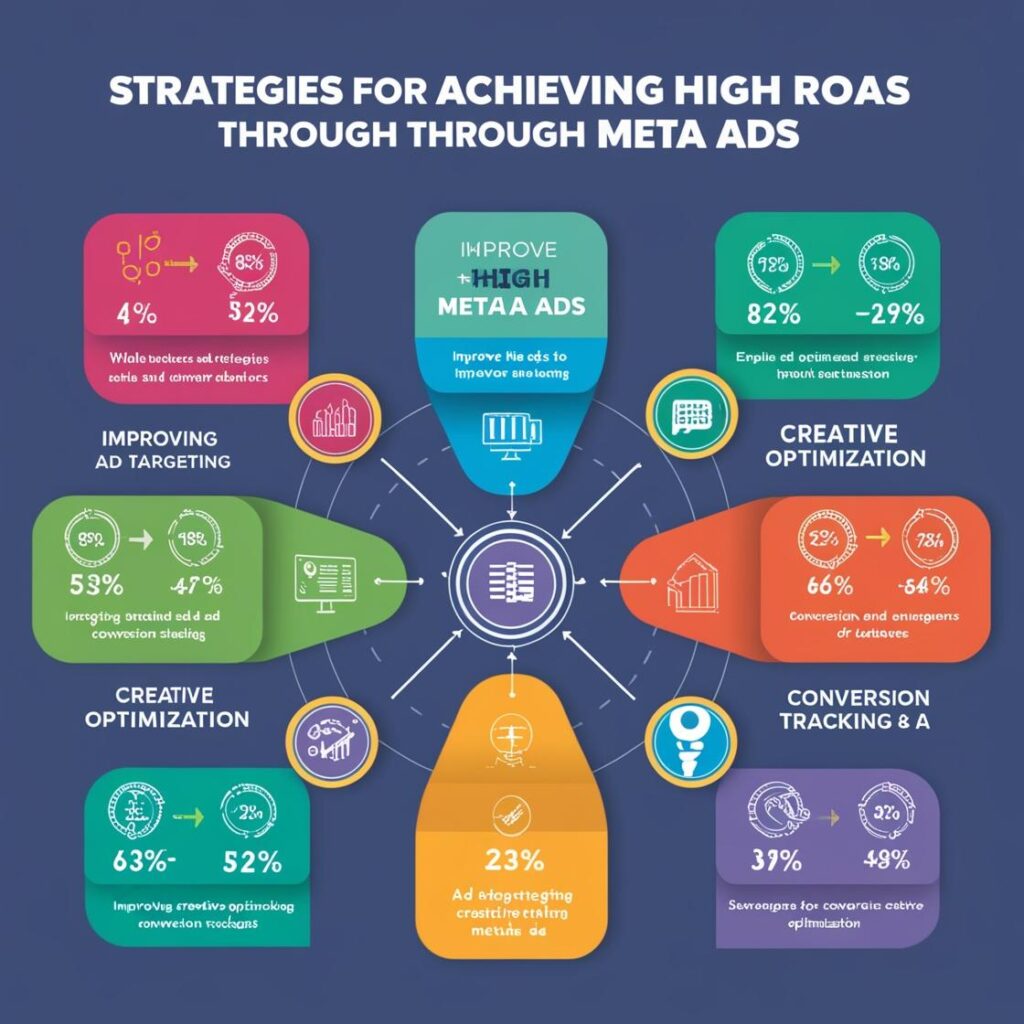
How to Get High ROAS Through Meta Ads?
This is the golden question: How to get high ROAS through Meta ads?
The answer lies in continuous optimization, smart targeting, and testing. Here are some key elements:
A/B Testing
Test multiple versions of ad creatives, copies, and CTAs. Measure which versions convert best and allocate more budget to winners.
Retargeting and Upselling
Most users don’t purchase on their first visit. Retargeting brings them back with compelling offers or reminders. Post-purchase upsell campaigns help increase your average order value (AOV).
CBO (Campaign Budget Optimization)
Instead of manually allocating budgets to ad sets, let Meta automatically distribute your budget to the highest-performing ones using CBO. This enhances ROAS and minimizes manual errors.
Use Advantage+ Campaigns
Advantage+ (previously called Automated Ads) uses AI to optimize delivery and targeting. These campaigns often yield higher ROAS when paired with good creative and data.
The Role of Ecommerce Marketing Agency in Delhi
If you’re a growing brand and feeling overwhelmed managing everything from logistics to ad campaigns, this is your cue to partner with an expert ecommerce marketing agency in Delhi.
Why Partner with an Agency?
- Expertise in ad management and optimization
- Creative production and testing at scale
- Data-driven decision making
- Advanced tracking using Meta Pixel and Events API
- Dedicated performance reporting
A seasoned agency not only runs your ads but also aligns them with your broader business goals.
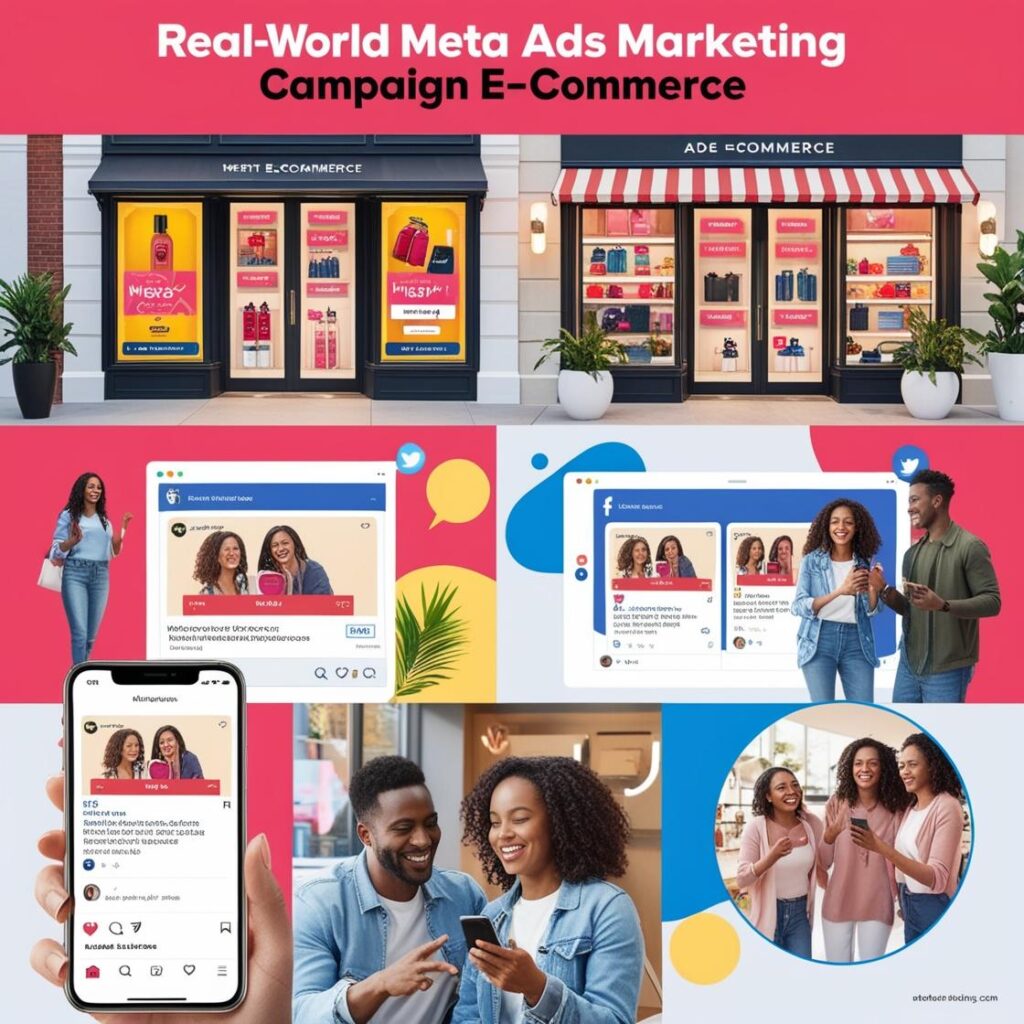
Real-World Meta Ads Marketing for Ecommerce Business
Let’s look at a sample structure of an effective Meta ads marketing for ecommerce business campaign:
Budget Breakdown Example (₹1,00,000 Monthly Spend)
- TOFU (30%) – ₹30,000: Brand awareness, Instagram reels, influencer clips
- MOFU (40%) – ₹40,000: Website visitors, cart abandoners, email subscribers
- BOFU (20%) – ₹20,000: Purchase-intent audience with discount offers
- Testing & A/B (10%) – ₹10,000: New creatives, copy testing, new audience segments
Metrics That Matter
- ROAS (Target: 3x to 6x)
- CPC (Cost Per Click)
- CPM (Cost Per 1000 Impressions)
- CTR (Click Through Rate)
- Conversion Rate
A performance marketing-focused strategy ensures you spend smart and scale fast.
Tools to Enhance Meta Ads Performance
To improve performance, consider using tools that support your Meta ads journey:
Meta Pixel
Track user actions across your website and retarget effectively.
Conversion API
Allows you to send user actions directly to Meta, improving tracking accuracy after iOS 14+ updates.
Product Catalog
Essential for dynamic product ads — automatically pull products into your creatives based on user behavior.
Common Mistakes That Kill ROAS
Even with the best strategy, these mistakes can waste your ad spend:
- Targeting too broad or irrelevant audiences
- Poor quality creatives
- Not testing landing pages
- Ignoring retargeting
- Scaling too fast without testing
Avoiding these pitfalls is essential for anyone learning how to scale ecommerce sales through Meta ads effectively.
Conclusion
Scaling your e-commerce store with Meta ads is not about spending more — it’s about spending smarter. With a solid funnel structure, continuous testing, and the right creatives, you can unlock high ROAS and exponential growth.
If you’re looking to scale and prefer working with experts, partnering with a trusted ecommerce marketing agency in Delhi can streamline your efforts and deliver faster results.
Remember, the ultimate goal is not just to get clicks — it’s to drive consistent, profitable sales.
FAQs
Q1. How to scale ecommerce sales through Meta ads without wasting money?
Start small, test thoroughly, use retargeting, and optimize creatives regularly. Always monitor ROAS before scaling your budget.
Q2. What is the best Meta ads strategy for ecommerce business beginners?
Use a three-stage funnel: awareness, consideration, and conversion. Focus on retargeting and build a strong product catalog for dynamic ads.
Q3. How much budget is ideal to start Meta ads for a small ecommerce business?
You can start with ₹500–₹1000/day, test different creatives, and scale gradually based on ROAS.
Q4. Why should I hire an ecommerce marketing agency in Delhi?
Agencies bring experience, data-driven strategies, and the latest tools. They can manage campaigns more efficiently and deliver better results in less time.
Understanding Customer Lifetime Value in Digital Campaigns
In today’s performance-driven digital landscape, marketers are constantly seeking strategies that deliver long-term returns and help justify every marketing dollar spent. One of the most effective yet underutilized strategies is Understanding customer lifetime value in digital campaigns. Customer Lifetime Value (CLV) offers insight into how much a customer is worth to your business over the entirety of their relationship. By leveraging this metric, digital marketers can make smarter budgeting decisions, optimize campaigns, and foster lasting customer relationships.
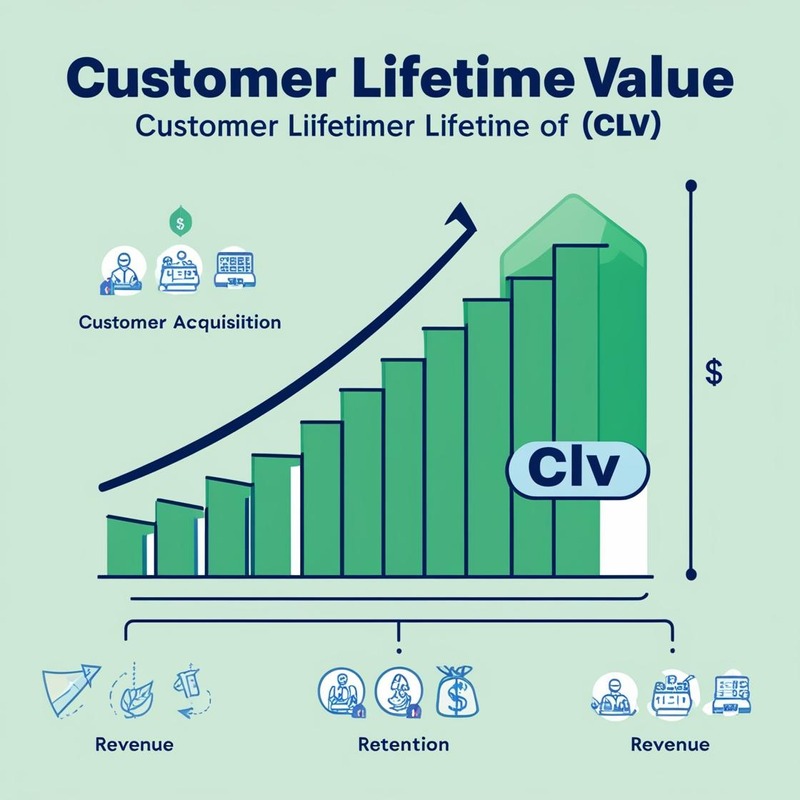
What is Customer Lifetime Value (CLV)?
Customer Lifetime Value refers to the total revenue a business can expect from a single customer account throughout the business relationship. It takes into account purchasing behavior, retention rate, and profit margins. CLV is crucial for understanding which customer segments are most profitable and worth investing in.
Formula for CLV
A basic formula to calculate CLV:
CLV = (Average Purchase Value) x (Average Purchase Frequency Rate) x (Customer Lifespan)
This can be expanded further by incorporating gross margin and discount rates to make it more accurate.
Why Understanding customer lifetime value in digital marketing campaigns Matters
Understanding customer lifetime value in digital campaigns can revolutionize your approach to targeting, budgeting, and engagement. It’s not just about cost-per-click anymore—it’s about the long-term value of each click.
Benefits of Knowing customer lifetime value for marketer
Understanding the Benefits of knowing customer lifetime value for marketers is crucial in today’s competitive landscape. It helps marketers allocate budgets more effectively, target high-value customer segments, and measure long-term profitability. By leveraging this metric, marketers can optimize their digital campaigns for sustainable growth and maximize return on investment.
Smarter Budget Allocation
Knowing how much a customer is worth allows marketers to allocate more budget to high-CLV audiences without overspending. For more budget management tips, check out our guide to high-ROI performance marketing.
Improved ROI Calculation
CLV shifts focus from short-term conversion metrics to long-term profitability, giving a clearer picture of campaign performance.
Targeting the Right Audiences
Marketers can use CLV data to create lookalike audiences based on high-value customers, improving ad targeting on platforms like Facebook and Google.
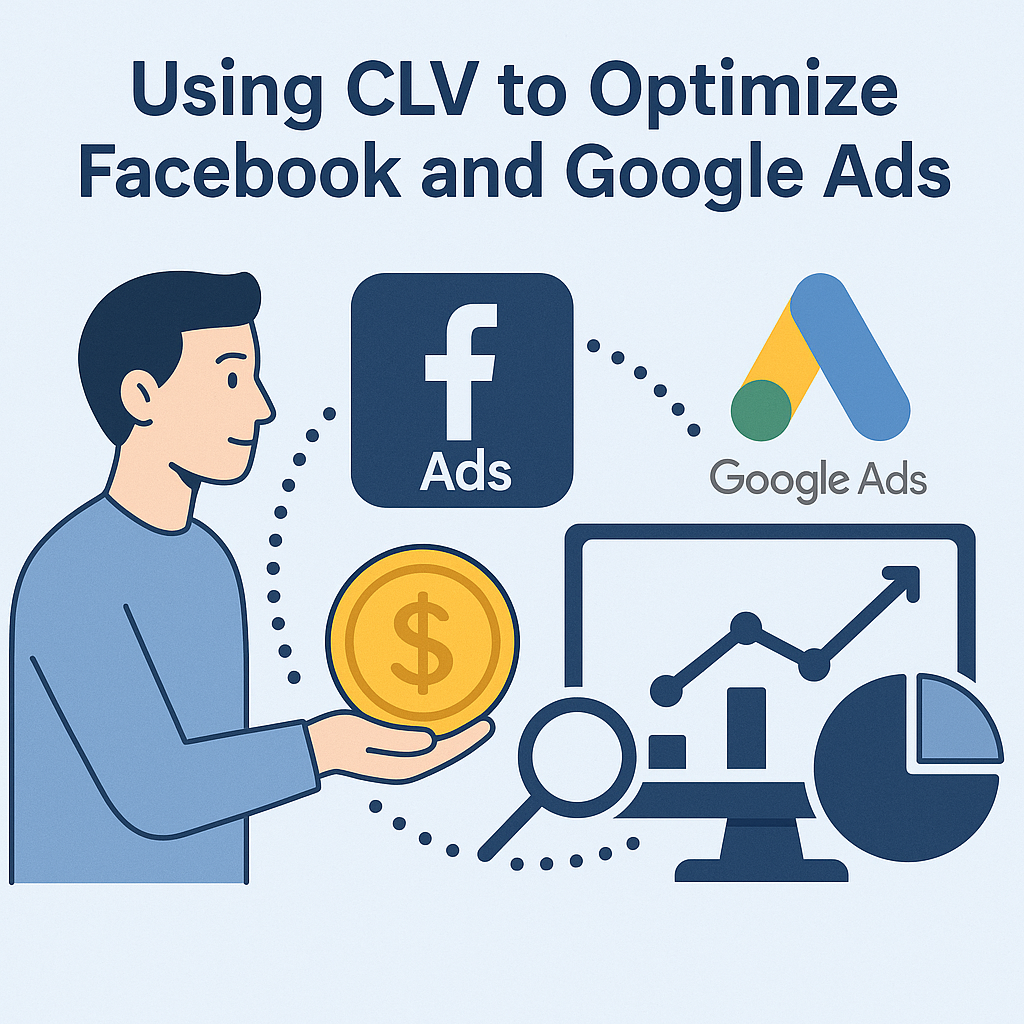
Using CLV to Optimize Facebook and Google Ads
CLV isn’t just a theoretical metric—it has real-world applications, especially in advertising. Using CLV to optimize Facebook and Google Ads can drastically improve the effectiveness of your digital campaigns.
Facebook Ads
By integrating CLV data, you can:
- Create custom audiences based on top-performing customer.
- Allocate more spend to high-return ad sets
- Improve ROAS by focusing on long-term value rather than just initial conversions
Google Ads
CLV can be synced with Google Analytics and Google Ads to:
- Adjust bidding strategies based on user value
- Refine keyword targeting
- Prioritize campaigns that attract high-CLV users
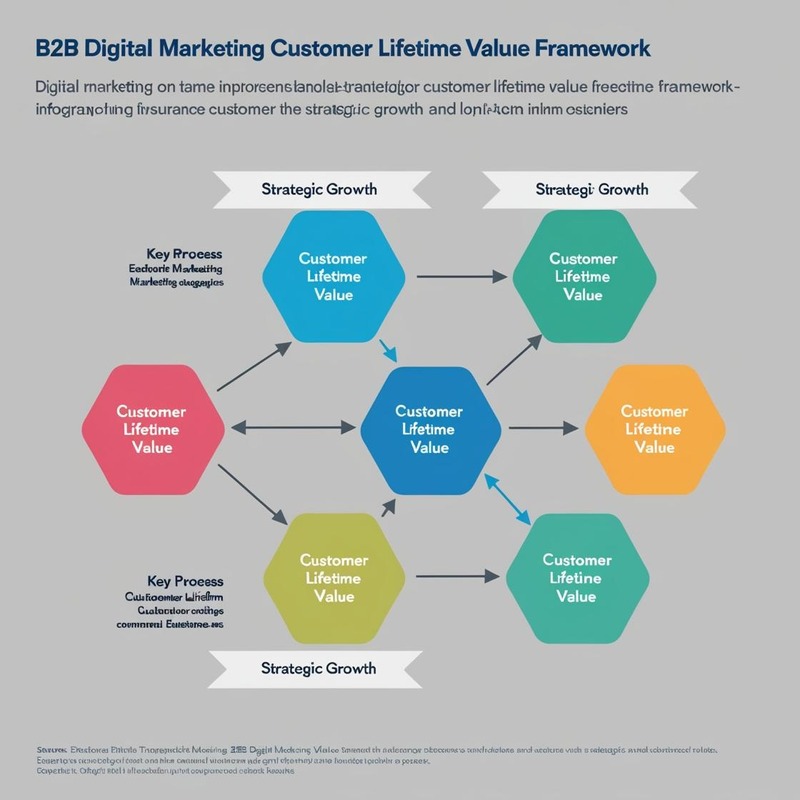
B2B Digital Marketing Customer Lifetime Value Framework
B2B marketers deal with longer sales cycles and higher-value transactions. The B2B digital marketing customer lifetime value framework is slightly more complex but equally essential.
Components of B2B CLV
- Contract Length: Often spans years
- Average Deal Size: Typically higher than B2C
- Customer Support Cost: Should be included in CLV
Strategies for B2B
- Use account-based marketing to attract high-CLV clients
- Personalize campaigns for decision-makers
- Leverage data and CRM tools to track and optimize CLV
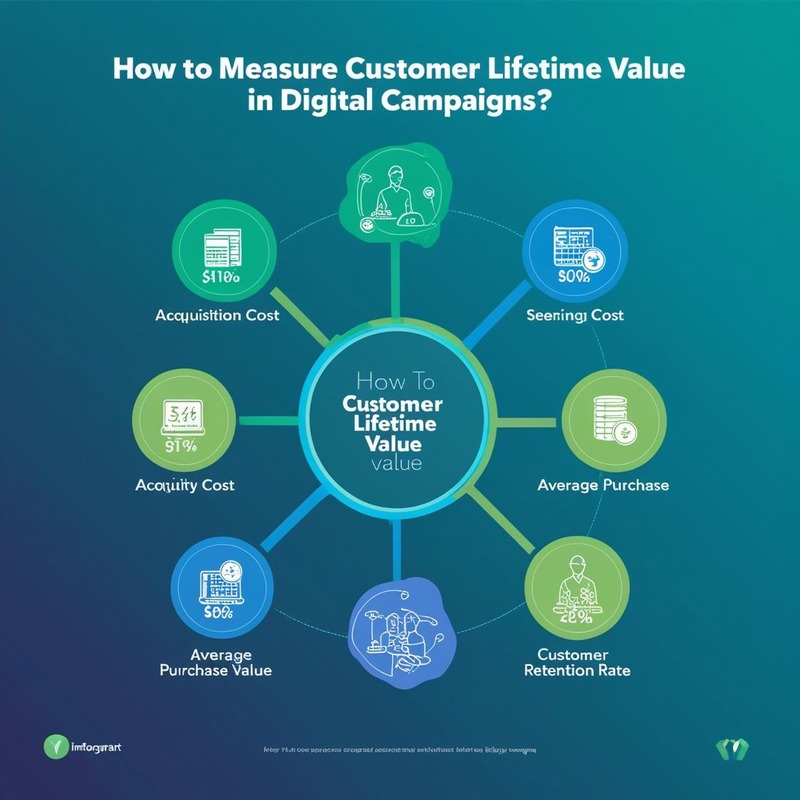
How to Measure Customer Lifetime Value in Digital Campaigns
Knowing how to measure customer lifetime value in digital campaigns is essential to apply it effectively. You can use both historical and predictive methods.
Historical CLV is based on actual past behavior:
- Transaction history
- Customer engagement
- Retention rates
Predictive CLV uses algorithms to forecast future value:
- Machine learning models
- Behavioral analytics
- Tools to Help:
- Salesforce
- Custom Excel models- Google Analytics
- HubSpot
- Salesforce
- Custom Excel models
Conclusion
Understanding Customer Lifetime Value in Digital Campaigns is no longer optional—it’s a strategic imperative. Whether you’re running Facebook ads or managing a B2B sales funnel, knowing your customers’ lifetime value can transform your approach. From smarter budget allocation to better customer targeting, CLV is the north star metric for any digital marketer who aims to play the long game.
FAQs
Q1: What is a good customer lifetime value?
A good CLV varies by industry, but it should always be higher than your customer acquisition cost (CAC). A common benchmark is CLV being at least 3x the CAC.
Q2: How often should I calculate CLV?
It’s best to review CLV quarterly, especially if your business has seasonal trends or frequent campaign changes.
Q3: Can small businesses benefit from CLV analysis?
Absolutely. Even with a small customer base, CLV can help prioritize efforts on the most profitable customers.
Q4: Is CLV more useful in B2B or B2C?
Both. B2B has fewer customers but higher CLV per account. B2C has more volume, and tracking CLV helps identify the best segments to target.
How AI is Transforming Digital Marketing?
Introduction
Artificial Intelligence (AI) has become a game-changer in digital marketing, revolutionizing the way businesses interact with their audience, optimize campaigns, and generate content. From Chatbot marketing strategy to AI-based SEO optimization, AI is making digital marketing more efficient and personalized than ever before. This blog explores how AI is reshaping digital marketing and how businesses can leverage its power to stay ahead of the competition.
The Role of Digital Marketing with AI

1. Chatbot marketing strategy – Enhancing Customer Engagement
Chatbots have become an essential tool in digital marketing, providing 24/7 customer support and instant responses. Businesses are now leveraging AI-powered chatbots to improve user experiences, increase lead conversions, and streamline customer service processes. Here’s how chatbots are transforming marketing:
- Instant Customer Support: AI chatbots can handle multiple queries simultaneously, reducing wait times and improving customer satisfaction.
- Personalized Conversations: Machine learning in marketing allows chatbots to analyze past interactions and tailor responses accordingly.
- Lead Generation and Nurturing: Chatbots can capture leads, qualify prospects, and nurture them through automated conversations.
- Automated Transactions: Many businesses integrate chatbots for seamless purchase processes within social media and websites.
Enhance your business with AI and Chatbot marketing strategy. Discover how AI-driven SEO, automation, and AI boosts social media strategy for growth.
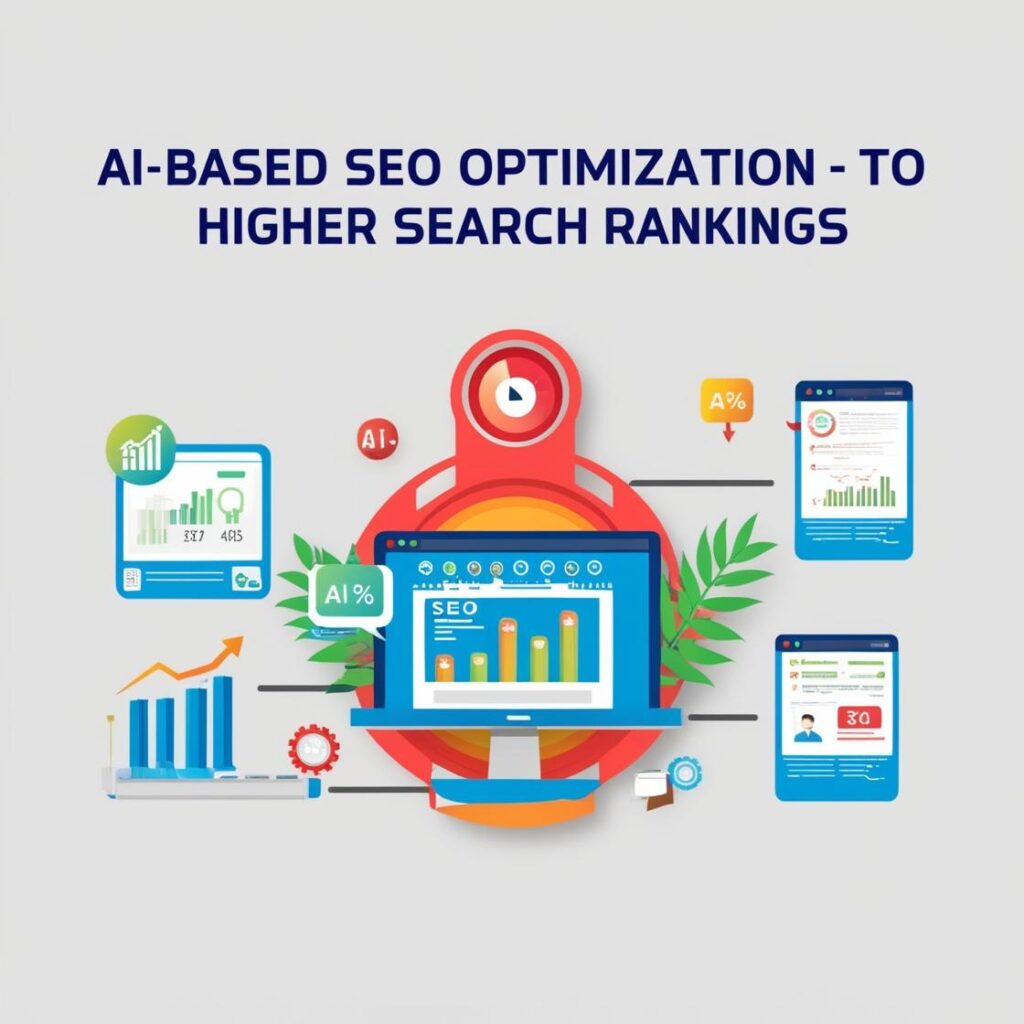
2. AI-Based SEO Optimization – Smarter Search Rankings
AI SEO optimization plays a crucial role, helping marketers enhance their rankings with data-driven strategies. AI-based SEO tools analyze vast amounts of data to provide actionable insights. Here’s how AI is improving SEO:
- Keyword Analysis and Prediction: AI tools identify high-performing keywords and predict search trends.
- Content Optimization: AI-driven platforms suggest content improvements based on user intent and search algorithms.
- Voice Search Optimization: With the rise of voice assistants, AI helps optimize content for conversational search queries.
- AI-Powered Analytics: AI evaluates website performance and suggests improvements to enhance rankings.
Moz’s AI-Powered SEO Strategies – Moz provides deep insights into AI-driven SEO.

3. Digital Marketing with AI – Smarter Campaigns, Higher ROI
AI-driven tools are making digital marketing campaigns more effective by automating tasks and analyzing customer behavior. Marketers can now optimize their advertising strategies based on AI insights, leading to higher ROI. Key benefits of AI in digital marketing include:
- Audience Targeting: AI analyzes customer behavior to create highly targeted ad campaigns.
- Ad Performance Optimization: Machine learning algorithms track and adjust ad spend in real-time to maximize results.
- Predictive Analytics: AI predicts customer actions and helps marketers tailor their strategies accordingly.
- Automation of Marketing Tasks: From email marketing to social media scheduling, AI automates repetitive tasks, saving time and effort.
HubSpot’s Guide to AI in Marketing – HubSpot provides valuable insights into AI-powered marketing strategies.

4. Machine Learning in Marketing – Understanding Consumer Behavior
Machine learning is a subset of AI that enables systems to learn and improve from data. In marketing, it helps businesses understand consumer behavior, segment audiences, and personalize marketing campaigns. Here’s how machine learning is shaping marketing:
- Customer Segmentation: AI classifies customers based on demographics, behaviors, and preferences.
- Behavioral Analysis: AI predicts purchasing patterns and helps marketers tailor campaigns.
- Dynamic Pricing: E-commerce businesses use AI to adjust pricing based on demand and customer behavior.
- Sentiment Analysis: AI analyzes customer feedback, reviews, and social media mentions to gauge brand perception.

5. AI and Content Marketing – Creating High-Quality, Engaging Content
Content marketing is a critical component of digital marketing, and AI is transforming the way content is created, optimized, and distributed. AI-powered tools assist marketers in generating high-quality content efficiently. Here’s how AI is changing content marketing:
- AI-Generated Content: AI tools like GPT-based models create engaging blog posts, product descriptions, and social media content.
- Content Personalization: AI customizes content based on user behavior and preferences.
- Content Curation: AI helps marketers find and suggest relevant content for their audience.
- Performance Analysis: AI tracks content performance and provides insights for future improvements.
Enhance brand engagement with our Social Media Marketing solutions.
Conclusion
AI is revolutionizing digital marketing by enhancing customer interactions, optimizing SEO, improving campaign effectiveness, and automating content creation. A well-implemented Chatbot marketing strategy can drive engagement, increase conversions, and improve customer satisfaction. As AI continues to evolve, businesses must embrace its capabilities to stay ahead in the competitive digital landscape. By integrating AI-based SEO optimization, machine learning in marketing, and AI and content marketing, businesses can achieve remarkable growth and success in digital marketing.
FAQs
1. How can AI improve chatbot marketing strategy?
AI improves chatbot marketing by enabling personalized conversations, automating responses, and enhancing customer engagement. AI-driven chatbots analyze user behavior to provide accurate and relevant information.
2. What is AI-based SEO optimization?
AI-based SEO optimization involves using artificial intelligence to analyze search trends, optimize content, and improve search rankings. AI tools help with keyword research, voice search optimization, and website performance analysis.
3. How does machine learning impact digital marketing?
Machine learning helps marketers understand customer behavior, segment audiences, and create personalized marketing campaigns. It also enables predictive analytics, dynamic pricing, and sentiment analysis.
4. What are the benefits of AI in content marketing?
AI enhances content marketing by generating high-quality content, personalizing recommendations, curating relevant content, and analyzing performance metrics to improve engagement and conversion rates.
SEO Vs SEM: Which is Better for Your Business?
In the ever-evolving world of digital marketing, businesses are constantly seeking strategies to enhance their online presence. Two popular methods that often come up in conversations are Search Engine Optimization (SEO) and Search Engine Marketing (SEM). But which one is better for your business? This blog explores the SEO Vs SEM comparison to help you make an informed decision.
Understanding SEO and SEM
What is SEO?
SEO stands for Search Engine Optimization. It focuses on improving a website’s organic search visibility by optimizing various elements like content, keywords, meta tags, and backlinks. The primary goal of SEO is to rank higher on search engine results pages (SERPs) without relying on paid ads.
What is SEM?
SEM, or Search Engine Marketing, includes paid strategies like Pay-Per-Click (PPC) advertising to boost a website’s visibility on search engines. SEM ensures immediate results and drives targeted traffic by bidding on relevant keywords.

SEO Vs SEM Comparison
To understand the difference between SEO and SEM, let’s compare them on various factors:
1. Time to Results
- SEO: SEO requires time and consistent efforts to show results. It’s a long-term strategy that may take months but offers sustainable benefits.
- SEM: SEM delivers instant visibility and traffic since it involves paid advertisements. However, results cease as soon as you stop running ads.
2. Cost-Effectiveness
- SEO: Once implemented, SEO is cost-effective and ensures long-term ROI. Businesses can also leverage affordable digital marketing packages for ongoing SEO efforts.
- SEM: SEM demands a consistent budget for ads. It’s ideal for businesses that need immediate results and have a flexible marketing budget.
3. Sustainability
- SEO: Sustainable and provides long-term value as optimized pages continue to rank higher over time.
- SEM: Results are temporary and depend on ad spend. When ads stop, traffic usually declines.
4. Target Audience
- SEO: Ideal for capturing audiences who rely on organic search results.
- SEM: Best for targeting specific demographics and geographical areas with customized campaigns.
Benefits of SEO and SEM for Business

Benefits of SEO for Business
- Cost Efficiency: Organic traffic is free after initial optimization efforts.
- Credibility: Higher rankings boost trust among potential customers.
- Sustainability: Long-lasting results with consistent efforts.
- Enhanced User Experience: Improves website usability and navigation.
Benefits of SEM for Business
- Quick Results: Instant traffic and leads.
- Highly Targeted Ads: Allows businesses to reach specific audiences.
- Flexibility: Campaigns can be adjusted in real-time for better performance.
- Boosts Brand Awareness: Paid ads prominently display your business on SERPs.
For startups, investing in SEM for startups with affordable packages can provide a solid foundation for long-term growth.
Website SEO Optimization Services: Why They Matter

Website SEO Optimization Services are essential for businesses to:
- Improve organic visibility and rankings.
- Enhance website performance.
- Build authority and credibility in their niche.
SEO requires time and consistent efforts to show results, as supported by Google’s Search Central.
Digital Marketing for Startups: The Role of SEM

Startups often face the challenge of gaining visibility in competitive markets. With SEM, startups can:
- Quickly generate leads and sales.
- Test and refine their marketing strategies.
- Reach a larger audience in less time.
SEO Vs SEM: Which is Better for Your Business?
The answer depends on your business goals:
- Choose SEO if you’re looking for sustainable, cost-effective growth and have the time to invest in organic strategies.
- Choose SEM if you need immediate results, have a flexible budget, and want to target specific audiences.
Professional website SEO optimization services can help improve rankings and organic traffic. Additionally, implementing Local SEO Tips can enhance visibility for location-based searches.
Conclusion
Both SEO and SEM have their unique advantages, and the right choice depends on your business needs. For long-term growth, SEO remains a cost-effective solution, especially with professional website SEO optimization services. On the other hand, SEM can be a game-changer for businesses seeking instant visibility and leads. Combining both strategies often yields the best results, providing a balance of short-term and long-term benefits.
FAQs
- What is the main difference between SEO and SEM? SEO focuses on organic search results, while SEM involves paid advertising for instant visibility.
- Are SEO and SEM complementary? Yes, combining SEO and SEM can maximize your online presence and drive both immediate and long-term results.
- How can startups benefit from SEM? SEM helps startups gain quick visibility, attract targeted audiences, and generate leads in competitive markets.
- Is SEO a better option for small businesses? Yes, SEO is cost-effective and sustainable, making it an ideal choice for small businesses looking to grow organically.
Local SEO Strategies for Small Business: Boost your business now!
Introduction
Small businesses have a ton of chances to expand their reach and establish their local brand in today’s digital-first society. Connecting with local clients, increasing visibility, and cultivating community loyalty all depend on local SEO. If you’re seeking actionable guidance on how to expand your business online, this article will give you insights into SEO strategy, including GBP optimization, voice search suggestions, and ethical SEO methods. You can build a solid internet presence and accomplish long-term success with these small business growth suggestions.
Table of Contents
Advanced Strategies for Google Business Profile Optimization

Why Google Business Profile is Crucial for Local Businesses?
Your GBP serves as the digital face of your business. It’s often the first point of contact for potential customers searching online. An optimized profile ensures you appear in local search results and Google Maps, driving more traffic to your store or website.
Tips to Optimize Your GBP
Ensure Complete and Accurate Information
- Make sure that your company’s name, address, and phone number are the same on all platforms. This increases search engine accuracy and fosters trust.
- Add relevant keywords in your business description to improve discoverability for specific services.
Use Visuals Effectively
- Post top-notch photos of your staff, facilities, and merchandise to give potential buyers an idea of what to expect.
- Create interesting content with short videos, including behind-the-scenes shots or client endorsements.
Leverage Customer Reviews
- Encourage satisfied customers to leave positive reviews. These significantly influence decision-making for new customers.
- Respond to all types of reviews—either negative or positive—to show your commitment to customer satisfaction.
Voice Search Optimization for Small Businesses

Why Does Searching with Voice Matter?
The rise of voice-enabled devices like Alexa, Google Assistant, and Siri has transformed how people search online. Voice searches are often locally focused, making them a vital component of your SEO strategy.
Tips for Voice Search Enhancement
Pay Attention to Conversational Keywords
- Incorporate long-tail keywords and organic language into your writing. “How can I grow my business online?” is one example.
- These conversational questions should be reflected in your FAQ section.
Make Yourself Mobile-Friendly
- Make sure your website loads fast and is responsive. Your chances of appearing in voice search results rise with a smooth mobile experience.
Incorporate Structured Data Markup
- To aid search engines in comprehending your company’s details, like operating hours and services offered, use schema markup.
If you’re seeking professional assistance, connecting with a professional digital marketing company that specializes in GBP optimization can help you to ensure your business stands out.
Local Link-Building Opportunities

Backlinks Are Important for Local SEO
Relevance and authority are established with the aid of high-quality backlinks from nearby websites. Additionally, they increase your website’s targeted visitors, which opens up new growth prospects.
Methods for Acquiring Local Backlinks
Collaborate with Local Organizations
- Partner with local influencers, bloggers, or businesses for mutual promotions.
- To obtain backlink and remarks, support neighborhood events or take part in community service projects.
Create Valuable Local Content
- Produce Useful Local Content Write blogs about community stories, local events, or attractions.
- Create localized instructions or advice to establish your company as an authority in the area.
Building strong local links is crucial, but Digital Walker offers tailored link-building services to support your business to grow.
SEO Ethics: White Hat, Black Hat, and Grey Hat

Understanding the Basics SEO Ethics
- White Hat SEO: adheres to search engine standards while emphasizing long-term outcomes and user experience.
- Black Hat SEO: Uses dishonest tactics, such as stuffing keywords and fabricating reviews, to make quick money but runs the danger of being penalized.
- Grey Hat SEO: Combines both strategies, which has considerable risks but can produce results.
Why Does SEO Ethics Matter in Small business growth?
- Ethical behavior avoids fines and guarantees ongoing growth.
- Prioritizing the user experience improves the reputation of your brand and fosters trust.
Our Expertise in SEO Ethics
Digital Walker specializes in using ethical and successful SEO ethics to support the expansion of your company. High-quality backlink building, voice searching preparation, and GBP optimization are some of the services we offer. To find out more, click here.
FAQs About SEO Tips and Business Growth
What is local SEO, and why is it important for small businesses?
Local SEO focuses on optimizing your online presence to attract customers from your geographic area. It’s crucial for driving foot traffic, building local credibility, and increasing sales.
How can I improve my business’s visibility in local search results?
Optimize your Google Business Profile, use local keywords, encourage customer reviews, and build backlinks from local websites.
Is voice integration necessary for small businesses?
Yes, as search with voice is growing rapidly, especially for local queries. Optimizing for it ensures you don’t miss out on this audience segment.
What are some common mistakes to avoid in local SEO?
Avoid inconsistent NAP information, neglecting customer reviews, and using unethical SEO tactics like keyword stuffing or buying fake backlinks.
How to Turn Black Friday Shoppers into Loyal Customers? Learn the trick now!
Businesses witness a surge of new customers eager to take advantage of massive bargains on Black Friday, the busiest shopping day of the year. Black Friday sales are fantastic, but the true test is converting those one-time buyers into devoted, regular clients who return long after the holidays are past. Providing a high-quality product is not enough to establish enduring client relationships; continuous interaction and careful follow-up after the sale are also necessary. We’ll look at post-sale interaction tactics in this article to assist you convert your Black Friday buyers into devoted, lasting clients.
Table of Contents
Why Post-Sale Engagement Matters for Customer Loyalty?

The Black Friday Rush: A Golden Opportunity
Customers hurry to get the greatest discounts on Black Friday, and even though many of them may be first-time purchasers, this surge of buyers offers a big opportunity. This is the ideal moment for businesses to leave a lasting impression in addition to making a sale. But after the deal is finished, the hard work doesn’t end.
The Importance of Building Trust and Loyalty After the Sale
It’s critical to demonstrate to your customers that you value their business beyond just their money after the transaction. A satisfying post-purchase experience raises the possibility of recurring business, cultivates goodwill, and creates trust. Customers that are satisfied and feel appreciated are more likely to come back and refer others to your company.
Post-Sale Engagement Strategies to Build Customer Loyalty

Send Personalized Thank You Messages
Ensuring that your consumers feel valued is the first step in post-sale engagement. An excellent method to acknowledge their purchase and show your appreciation is with a handwritten thank-you note. A straightforward, customized “thank you” email can make a big difference in the client experience.
By mentioning their particular purchase, you can personalize it and go beyond simply saying “thank you.” Give them some small incentive, like free shipping or a discount, for their subsequent purchases. A one-time consumer may become a repeat customer as a result of this simple gesture.
Encourage Feedback and Reviews
Asking for feedback is a good idea once your customers have had a chance to enjoy their Black Friday purchases. In addition to providing you with insightful information on how to enhance your goods or services, reviews and testimonials assist you gain the trust of potential clients.
Make it simple by including a direct link to your review platform in your follow-up email asking for a review or comments. Giving consumers rewards, like loyalty points or a discount on subsequent purchases, might motivate them to talk about their experiences. Future sales depend on prospective consumers’ trust, which is increased by positive evaluations.
Build a Strong Loyalty Program
One of the best strategies to convert a first-time customer into a repeat one is through loyalty programs. You may encourage repeat business by providing incentives for interaction, reviews, and purchases. When a loyalty program is properly designed, it provides customers a sense of exclusivity and encourages them to return.
Create a straightforward points-based system where clients receive rewards for each purchase they make; there’s no need to overcomplicate it. Make these prizes enticing and unique. For instance, provide customers with early access to deals and promotions or discounts on items that are comparable to what they bought.
Use Email Marketing for Post-Sale Engagement
After the sale, email marketing is a crucial tool for maintaining contact with your clients. Make use of it to maintain brand awareness and cultivate the relationship. Create a customized experience instead of sending generic emails.
Sending post-purchase emails with product recommendations based on the customer’s previous purchases is one example. Additionally, you can provide early access to sales events, special discounts, or first looks at new products.
Small Businesses can choose Digital Walker Marketing Company for budgeted Email Marketing Services which target distinct customer groups with content that speaks to their particular interests by segmenting brand’s email list.
Create Consistent Value Through Content
After the Black Friday craze has passed, keep providing your customers with useful and interesting information. These could include how-to videos, product manuals, or tutorials that help buyers make the most of their purchases.
For example, send a follow-up email with a usage guide or maintenance advice to a consumer who purchased a beauty product during your Black Friday sale. You may send exercise routines or fitness advice if you sell fitness equipment. You may demonstrate to your clients that your relationship with them extends beyond the sale by producing valuable content.
Provide Exceptional Customer Service
One of the main pillars of post-sale engagement is outstanding customer service. How you respond to a consumer who has problems with their purchase can make or ruin your relationship with them. Providing simple swaps, refunds, and support can significantly increase customer satisfaction.
Respond promptly and proactively to any queries or worries, and always go above and beyond to find a prompt and expert solution. You can demonstrate to your consumers that you value them and are committed to giving them a satisfying experience at every touch point by offering exceptional customer service.
How to Keep the Sales Going After Black Friday
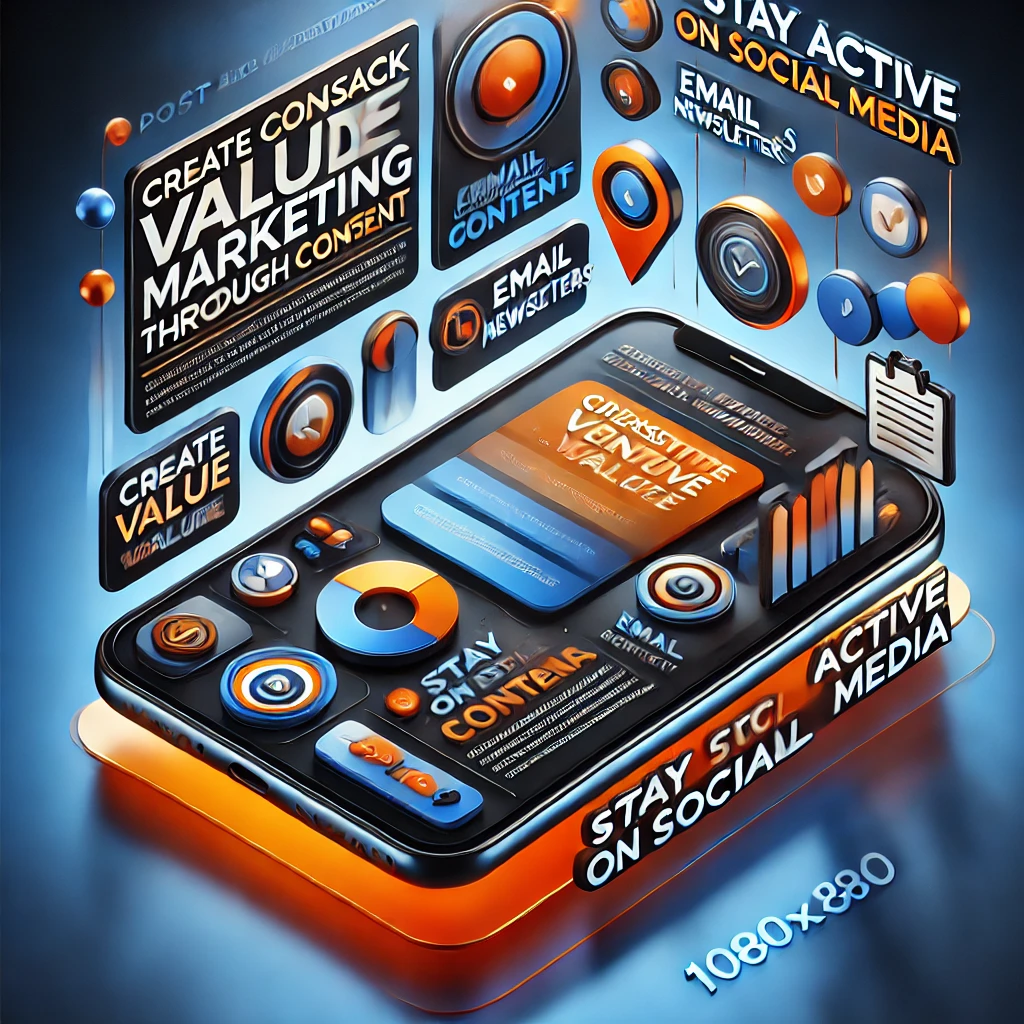
Create Consistent Value Through Content
After Black Friday, you should continue to be involved. Keep producing insightful material that engages your audience. Continue providing pertinent content that speaks to the interests of your clients through blog entries, email newsletters, and social media updates.
To assist customers get the most out of their purchases, think about providing special content like lessons, industry insights, or how-to guides. In addition to keeping customers interested, this will establish your brand as a useful asset.
Stay Active on Social Media
After Black Friday, social media is an effective strategy for maintaining interest. You may maintain a relationship with your customers by answering their comments, offering information about new products or forthcoming deals, and reposting user-generated content. Social media is also a great way to engage with your audience more deeply and demonstrate the personality of your brand.
Maintain a regular social media presence and invite customers to engage with your content. Reposting customer evaluations, holding competitions, or providing behind-the-scenes video can foster a feeling of community and increase loyalty.
One can also look for an expert Social Media Marketing Services to get better results. Many digital marketing now-a-days offer expert social media strategy to boost your sales.
Tools to Help You Engage Post-Black Friday Shoppers
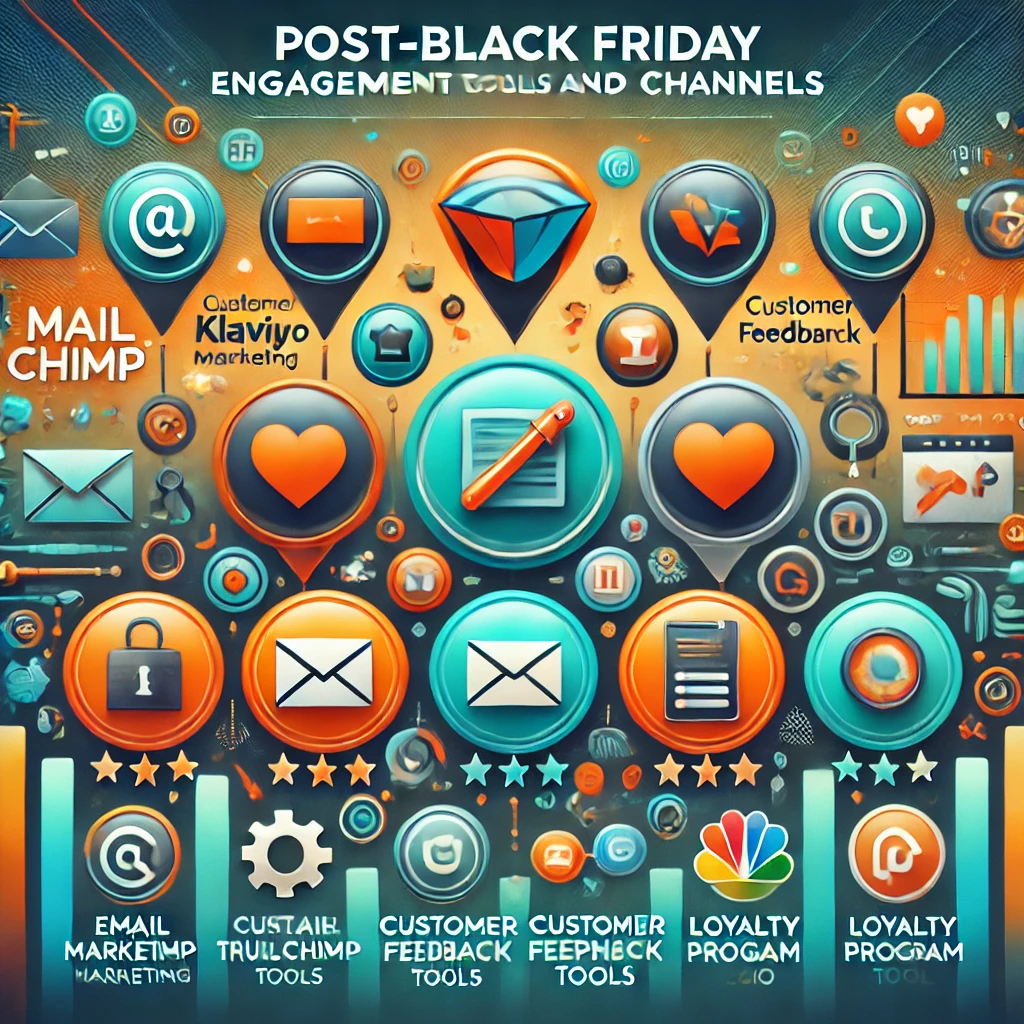
Email Marketing Tools
Use email marketing tools like Klaviyo or Mailchimp to make sure your post-purchase interaction runs well. You may observe consumer behavior, segment your audience for more focused marketing, and automate tailored email sequences with these tools.
Customer Feedback Tools
Tools like Yotpo and Trustpilot can help you easily collect and manage customer reviews. These platforms also allow you to display customer testimonials on your website, further building trust and credibility.
Loyalty Program Platforms
If you’re planning to implement a loyalty program, platforms like Smile.io or LoyaltyLion make it easy to create and manage reward programs that encourage repeat purchases.
Social Media Management Tools
For social media engagement, tools like Hootsuite or Buffer allow you to schedule and manage posts, track customer interactions, and engage with followers in real-time.
Conclusion
It takes a mix of valuable content, outstanding customer service, and targeted post-sale engagement to convert sales buyers into loyal customers. You may establish trust and cultivate enduring connections with your clients by demonstrating that they are more than just a transaction. Keep in mind that while the sale may expire, the chance to interact and foster loyalty never ends. If you put effort into cultivating these connections, your Black Friday buyers will return for years to come.
FAQs
1. How can I turn Black Friday shoppers into repeat customers?
Provide personalized experiences, offer loyalty rewards, and engage with follow-up emails that highlight new offers or recommend related products. Make them feel valued post-purchase.
2. What are the best post-sale engagement strategies for Black Friday?
Leverage email and SMS campaigns for updates, exclusive discounts, and personalized recommendations. Use retargeting ads and loyalty programs to maintain engagement after the sale.
3. How can personalized communication help retain Black Friday shoppers?
Personalized emails with product suggestions and exclusive offers make customers feel recognized, enhancing loyalty and encouraging them to return for future purchases.
4. What role does customer feedback play in post-purchase engagement?
Collecting feedback allows you to refine your products and services. Sharing positive reviews boosts credibility, while addressing concerns shows customers you care, driving retention.
5 Proven Social Media Marketing Tips to Boost School Engagement
Social media marketing for schools has developed into an effective tool to engage their community, make connections, and draw in new students. It is no more merely a place for casual exchanges. Schools may spread their message, tell their story, and create a feeling of community among students, parents, and alumni by using these appropriate social media marketing tactics.
If you’re ready to leverage the power of social media, here are five effective marketing tips for schools to build engagement and grow their online presence.
Table of Contents
Setting Up Your School’s Social Media Presence
Effective social media marketing for schools starts with setting up your school’s social media presence. You can create a powerful online presence that enhances your overall digital marketing for schools strategy by knowing your target audience and choosing the appropriate channels. This guarantees that your school has a meaningful relationship with the community at large, parents, and students.

Define Your School’s Target Audience
Understanding your audience is crucial:
- Identify key demographics like students, parents, alumni, and prospective families.
- Create detailed buyer personas to shape your content and communication.
- Consider the preferences and online habits of each group, ensuring your efforts are relevant.
Choose Your Primary Social Media Platforms
Not every platform is created equal. Select those that align with your goals:
- Focus on platforms where your audience is most active, such as Facebook for parents or Instagram for students.
- Explore the unique features of each platform to maximize their potential, like LinkedIn for professional updates.
- Start small—master one platform before expanding to others to avoid feeling overwhelmed.
Creating Engaging Content
Your content is the heart of your social media strategy. It should captivate, inform, and inspire your audience. You may engage students, parents, and alumni while building enduring relationships by creating posts that speak to your audience, highlight your school’s distinctive narrative, and complement your entire digital marketing for schools .
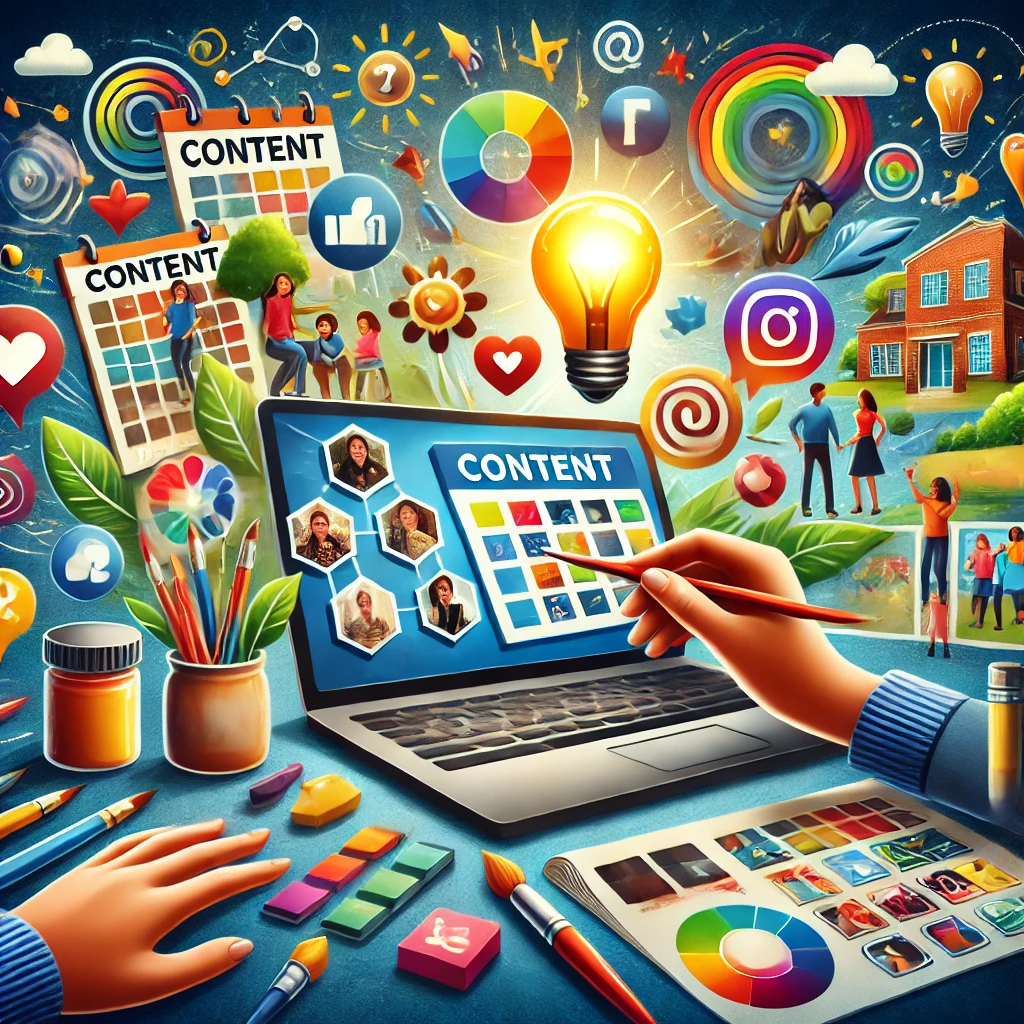
Develop a Content Strategy
Planning ensures consistency and quality:
- Set clear objectives like increasing likes, shares, or website visits.
- Use a content calendar to schedule posts in advance.
- Balance promotional content with educational and entertaining posts to keep your audience engaged.
Showcase Your School’s Story
People connect with stories, not statistics:
- Share student achievements, alumni success, and impactful school projects.
- Post behind-the-scenes glimpses to humanize your institution and build trust.
- Utilize photos, videos, and graphics to make your story visually appealing.
Social Media is all about consistency and if you can’t then we can maintain that for you. Let Digital Walker take charge of your social media marketing for schools.
Building Engagement and Community
Engagement is about fostering genuine connections, not just chasing likes and follows. Your school can improve its online presence and boost its overall efforts at digital marketing for schools by engaging with your audience directly and building real connections.

Engage with Your Audience
Be present and approachable:
- Respond to comments, messages, and questions promptly and thoughtfully.
- Monitor conversations about your school using social listening tools.
- Encourage interaction by hosting polls, quizzes, or asking for feedback.
Run Targeted Social Media Ads
Paid ads can expand your reach:
- Target ads based on location, age, interests, or other demographics.
- Experiment with different ad formats, such as carousel ads or video ads.
- Track performance metrics like click-through rates and conversions to refine your strategy.
If you are concern about the Google Ads for schools, digital marketing agency provides best advertising services for best results and that too within your budget .
Measuring Success and Improvement
A data-driven approach helps you continuously optimize your efforts. If you want to improve your school social media marketing, you must measure progress and success. To improve outcomes and audience satisfaction, your school can enhance its digital marketing efforts by examining engagement metrics and tracking data.

Use Data to Drive Social Media Decisions
Analytics reveal what works and what doesn’t:
- Monitor engagement metrics such as likes, comments, and shares.
- Analyze audience behavior to identify trends and preferences.
- Refine your content based on these insights for better results.
Optimize Your Posting Schedule
Timing matters in social media:
- Identify the best times to post by reviewing past engagement data.
- Test different schedules to discover what resonates with your audience.
- Use scheduling tools to ensure consistent posting without overwhelming your team.
Advanced Strategies
Once you’ve mastered the basics, consider taking your social media game to the next level. Using cutting-edge social media marketing techniques for schools can help your organisation remain on the cutting edge. You may make a lasting impression and differentiate your school from the competition by adopting modern techniques and integrating them into your digital marketing for schools plan.

Consider a Virtual Campus Tour
Virtual tours are a fantastic way to showcase your school’s facilities:
- Use 360-degree videos or virtual reality to create an immersive experience.
- Highlight classrooms, sports facilities, and other unique aspects of your campus.
- Share these tours widely to attract prospective families.
Stay Up-to-Date with Social Media Trends
Adaptation is key in the digital landscape:
- Follow industry leaders and influencers to keep up with new features and best practices.
- Experiment with emerging platforms like TikTok to engage younger audiences.
- Attend workshops or webinars to stay ahead of the curve and gain new ideas.
Conclusion
Building relationships, communicating your school’s ideals, and interacting with the community are all important aspects of social media marketing for schools. Your educational institution may increase participation, draw in potential families, and keep up a solid online presence by putting these suggestions into practice.
Recall that maintaining consistency, tracking your progress, and adapting to the rapidly changing digital scene are the keys to success. Thus, begin modestly, try new things, and see how your school’s internet presence develops.
FAQs
1. How can schools handle negative feedback on social media?
Respond calmly and professionally. Acknowledge the feedback, address concerns, and take the conversation offline if needed. Use it as an opportunity to improve.
2. Should schools post daily on social media?
Posting frequency depends on your audience and platform. Aim for consistent posting (e.g., 3–4 times a week) without sacrificing quality.
3. Can social media marketing be effective without a budget for ads?
Yes, organic strategies like engaging posts, consistent interaction, and community involvement can yield great results, although ads can boost visibility faster.
4. What types of content are best for engaging younger audiences?
Short-form videos, interactive polls, memes, and trending challenges resonate well with younger demographics. Focus on platforms like Instagram, TikTok, or Snapchat.
5 Effective Hotel Marketing Strategies to Attract More Guests
Table of Contents
Why Hotels Need to Have Good Online Visibility
Online visibility is crucial for hotels to stand out and draw in more visitors in the highly competitive environment of today. Because more and more tourists are using the internet to find, evaluate, and reserve lodging, hotels need to be simple to find on search engines and social media. Building credibility, increasing direct bookings, and leaving a lasting brand image are all facilitated by having a good web presence. In order to accomplish this, hotels must implement strong hotel marketing strategies that tackle important hotel marketing challenges in addition to increasing recognition.
The five successful hotel marketing strategies listed below can help hotels increase their digital footfalls and draw in more visitors.
1. Improve Online Visibility with SEO
One of the biggest challenges hotels face is poor online visibility. To attract potential guests, hotels need to be easily found on search engines. Here are some hotel marketing tips using SEO that can significantly improve visibility:
- Keyword Optimization: Start by researching relevant keywords such as “luxury hotels in (location)” or “Budget-Friendly hotels near (tourist place)” and include them into website content, blog posts, and meta descriptions.
- Content Creation: Regularly create content that addresses travellers’ interests, such as local attractions, travel tips, or seasonal activities. This positions the hotel as a local authority and attracts organic traffic.
- Technical SEO: Optimize the website’s load time, mobile responsiveness, and URL structure to ensure smooth navigation. A well-structured site enhances user experience and increases chances of ranking higher.

How a Digital Marketing for Hotels work ::
A digital marketing agency such as Digital Walker can help implement an effective SEO strategy specified to the hotel’s needs, including performing keyword research, optimizing the website, and creating engaging content. They monitor SEO performance and adjust tactics as needed, ensuring the hotel stays visible and competitive in search engine results.
2. Boost Social Media Engagement
In today’s digital world, social media plays a crucial role in attracting local as well as global guests. However, simply having a presence on social platforms isn’t enough. A strategic approach tailored to each platform can make a significant difference in your hotel marketing:
- Tailored Content: Share high-quality images of the hotel, guest testimonials, and engaging posts about local events. Different types of content resonate with different audiences—Instagram can showcase visually appealing images, while LinkedIn might be better for business travellers.
- Engage with Followers: Actively respond to comments, questions, and reviews. This helps build trust and loyalty of the hotel brand.
- Use Influencers: Partnering with local influencers can broaden the reach and expose the hotel to new audiences.

How a Digital Marketing for Hotels work :
A digital marketing company’s knowledge of Social Media Strategy guarantees that postings are tailored for reach and engagement. In order to preserve a positive brand image and help the hotel build closer ties with prospective visitors, agencies can produce customized content, find the best influencers, and oversee interactions.
3. Manage Reputation Effectively
Managing online reputation is crucial for attracting new guests. Reviews and ratings on platforms like TripAdvisor, Google Reviews, and social media influence travellers’ booking decisions. To address hotel marketing challenges related to reputation management, hotels should:
- Monitor Reviews: Regularly check and respond to reviews. Acknowledging both positive and negative feedback demonstrates that the hotel cares about guest experiences.
- Encourage Positive Reviews: Politely ask satisfied guests to leave a review, which can boost credibility and influence other travellers.
- Handle Negative Feedback Professionally: Negative reviews are inevitable, but handling them professionally can prevent potential damage and showcase excellent customer service.

How a Digital Marketing for Hotels work :
Monitoring reviews can be handled by a digital marketing agency, which will guarantee prompt reactions to both favorable and unfavorable comments. They can encourage happy customers to write reviews, offer advice on how to handle concerns, and put review management technologies into place. Effective reputation management aids in the development of trust and increases a hotel’s attractiveness to prospective visitors.
4. Optimize Paid Advertising for Higher Conversion Rates
Paid advertising is a powerful tool, but hotels often struggle with low conversion rates either because of tight budget or wrong targeting. By refining ad targeting and optimizing campaigns, hotels can improve ROI and attract more guests:
- Target Specific Audiences: Create campaigns that focus on target audiences, such as family travelers, couples, or business travelers. This allows for tailored messaging and better ad relevance.
- Use Retargeting Ads: Retarget users who previously visited the website but didn’t complete a booking. Retargeting can remind potential guests of the hotel and increase the chances of a conversion.
- A/B Testing: Experiment with different ad copy, visuals, and calls to action. Testing helps identify what resonates best with the audience and improves campaign performance.

How a Digital Marketing for Hotels work :
Effective paid campaign’s management is within the expertise of Digital Walker Marketing Company. To continuously enhance ad performance, they can execute A/B testing, apply retargeting tactics, and build up precise targeting. This guarantees that more leads will become visitors and that the hotel marketing will get the most out of its advertising money.
5. Update and Optimize the Website
A hotel’s website is often the first impression potential guests get, making it crucial for the site to be modern, user-friendly, and responsive. In this era of AI Assisted websites, outdated websites can drive users away and impact bookings. To enhance user experience and increase hotel visibility online, hotels should consider:
- Mobile Responsiveness: Ensure the website is fully functional and visually appealing on all devices, especially mobile, as many travellers use smartphones to book.
- Fast Load Speed: A slow website can frustrate users and lead to high bounce rates. Optimize images, use caching, and consider a reliable hosting provider to improve speed.
- Clear Calls to Action: Don’t be too complicated to mislead the guest. Use prominent buttons for booking, contact information, and special offers. Easy navigation encourages users to take action and simplifies the booking process.

How a Digital Marketing for Hotels work :
To make a website more user-friendly and adaptable to every device, a digital marketing agency can provide full-fledged Website Management Services where they do an audit, pinpoint areas that need work, and apply improvements. In order to improve the user experience and raise the possibility of direct bookings, they can also optimize the site’s loading speed and increase design features.
Conclusion
Attracting more guests to a hotel requires a multifaceted approach. By addressing common hotel marketing challenges with these five effective hotel marketing strategies—improving online visibility with SEO, boosting social media engagement, managing reputation, optimizing paid advertising, and updating the website—hotels can stand out in a competitive market. A comprehensive Digital Marketing for Hotels that combines these elements will ensure that the hotel not only attracts more guests but also retains them, building a loyal customer base and enhancing long-term success.
FAQs Related hotel marketing strategies :
How can hotels use email marketing to increase guest engagement?
Hotels can use email marketing to send personalized offers, promotions, and event updates, aligning with hotel marketing strategies to boost guest engagement and loyalty.
What are some cost-effective hotel marketing strategies for small properties?
Small properties can focus on local SEO, social media engagement, and email campaigns, addressing hotel marketing challenges and increasing hotel visibility online with minimal costs.
How can hotels leverage video marketing to promote their brand?
Hotels can use video marketing to showcase amenities, guest experiences, and local attractions, a key component of Digital Marketing for Hotels, helping to increase hotel visibility online.
What are the best practices for targeting international travelers in hotel marketing?
For international travelers, hotels should implement localized SEO, multilingual content, and targeted hotel marketing strategies, addressing unique cultural preferences and increasing global visibility.
How can hotels measure the effectiveness of their digital marketing efforts?
Though, digital marketing company will provide a detailed report at the end of the month regarding all the work they did and profits earned. But Hotels can also track metrics like website traffic, conversion rates, and ROI from ads using tools to measure the impact of Digital Marketing for Hotels.
How Generative AI Boost Social Media Strategy For Brands?
Social media is crucial and difficult to keep up to speed with in the ever-developing digital marketing world. Marketers often look for new strategies to make their social content easier and more effective, allow them engage better AND always one step ahead with the trends. This led to the rise of Generative AI in Social Media Marketing — an exceedingly fruitful tool capable of streamlining ideation, doubling-down on engagement strategies and essentially automating organic-style preprocessing. In this blog, I will explain how Generative AI is changing the way of social media content planning and execution by producing human-like output that helps brands to engage with their audiences.
Table of Contents
What is Generative AI in Social Media Marketing?
Generative AI offers you extraordinary tools to create, plan, and optimize your social media content. By automating aspects of the content creation process, generative AI allows brands to focus more on strategy and engagement. From generating engaging posts to analyzing real-time trends, the role of AI in social media has expanded, helping brands to stay competitive and consistently deliver content that resonates with their target audience.
Key Benefits of Generative AI in Social Media Marketing

1. Automating Content Ideation and Generation
Generative AI tools for social media marketing are excellent at automating content ideation and creation. It will then use those insights to recommend topics, or types of content that are likely to be popular with specific audiences. By offering AI-driven insights, creators and brands can ideate with confidence-based data to produce content that resonates with their intended audience.
For example, AI can analyze a brand’s past successful posts, current trending hashtags, and even competitor content, to suggest high-performing topics. This automated ideation can help social media managers generate a month’s worth of ideas in minutes, saving time and ensuring relevance.
You can opt for Digital Walker’s AI Assistance services, where you can fully utilize AI to improve productivity, simplify procedures, and create engaging, audience-specific experiences without lifting a finger.
2. Personalized Content Creation
Personalization is the name of the game in social media marketing, and generative AI can be used to generate content tailor-made for different audience segments. AI tools can be used to personalize not just user data like engagement history or browsing behaviour by leveraging machine learning algorithms in generating personal content.
Generative AI can generate custom text, captions, and even visual elements that cater to different demographics, allowing brands to speak to their audience in a more authentic way. With AI, brands can seamlessly create unique variations of a single campaign that feel personalized, without needing extensive manual input.
3. Enhanced Visual Content Generation
One of the most exciting roles of AI in social media is its ability to generate high-quality visual content. AI-driven image and video generators allow to create on-brand visuals quickly and efficiently. These tools can transform written descriptions into engaging graphics or suggest visual themes based on a brand’s identity, making it easier for small teams to keep up with the demands of social media without sacrificing creativity or quality.
AI-generated visuals are a game-changer for brands looking to elevate their aesthetics, ensuring their content stands out in crowded feeds. With the ability to produce high-quality, cohesive visuals in bulk, brands can consistently maintain a strong visual identity across platforms.
Streamlining Social Media Execution with Generative AI

1. Optimizing Posting Times and Frequency
In digital marketing, generative AI can determine the ideal posting timings by analyzing audience behavior, previous engagement metrics, and platform-specific algorithms. Artificial intelligence (AI) systems can automatically schedule posts at the best times to increase visibility and interaction by evaluating real-time data. With each post, this feature enables brands to increase interaction rates and eliminate guesswork.
AI can assist with frequency in addition to time, making sure that posts are published at the perfect pace to maintain audience interest without being overbearing. Based on audience behavior and platform conventions, AI-based solutions can forecast which frequency will maintain interest and engagement. You can always choose to seek expert Social Media Marketing Services to enhance your content strategy.
2. Real-Time Trend Analysis and Content Adaptation
In the ever-changing world of social media, trends change swiftly. Real-time keyword, hashtag, and trending topic analysis via AI-driven solutions provides businesses with the information they need to quickly modify their content plans. Trend data from generative AI can help determine what kind of material, such as an infographic, interactive poll, or short-form movie, should be posted.
Brands may remain relevant by producing content that reflects popular themes and issues and reacting in real time. This flexibility promotes a feeling of timeliness, audience connection, and engagement.
3. Data-Driven Content Performance Tracking
In social media marketing, generative AI is extremely useful for evaluating the effectiveness of content. Real-time feedback on the effectiveness of each post can be obtained through the use of AI tools, which can monitor metrics such as engagement rates, click-throughs, and conversions. With the use of these information, brands may improve their tactics, focusing more on what works and adjusting for what doesn’t.
Brands can consistently enhance their social media presence and make sure that every piece of content is in line with their objectives by knowing what kinds of material appeal to users the most.
Future of Social Media Marketing with AI
The future of social media marketing is set to be shaped by increasingly refined AI tools. As these tools become more advanced, they will provide creators with even greater insights into audience behavior, more automated creative processes, and new ways to engage with users. Generative AI will play a crucial role, making social media marketing more effective, efficient, and adaptive to the changing digital landscape.
Conclusion
Generative AI has redefined the possibilities in social media marketing, offering brands innovative ways to think, create, and optimize content strategies. From automating content generation to personalizing user experiences, the role of AI in social media marketing is transformative. By leveraging generative AI tools, brands can stay relevant, engage audiences effectively, and ultimately strengthen their social media presence. As AI continues to evolve, it will only further empower creators o r brands to deliver value-driven, authentic content that connects with audiences on a deeper level.
Generative AI tools for social media marketing :
| Tools | Features | Accessibility |
| Jasper | Social media captions and ad copy | Paid |
| ChatGPT | Ideas and captions | Free |
| Canva | AI visuals and templates | Free/Paid (Pro Version) |
| DALL-E Free | Image generation | Free |
| Google Trends | Keyword tracking | Free |
| Lumen5 | Blog-to-video | Free |
| Sprinklr | Content scheduling and analysis | Paid |
| Synthesia | AI video creation. | Paid |
| Piktochart | Infographics and visuals for social posts | Free |
6 Challenges Faced by Music Labels: How SEO Provides the Solutions
In today’s rapidly changing digital music scene, music labels can no longer depend solely on traditional marketing methods. With a constant influx of artists and new releases on streaming platforms, it takes a more strategic approach to stand out. SEO for music labels is vital, not just for gaining visibility but also for achieving long-term success. By utilizing Youtube SEO techniques, music labels can grow their music video’s reach, increase views, and ultimately promote their music globally.
In this blog, we will cover six key issues faced by music labels and how to incorporate the best SEO techniques for music labels into your strategy.

1. Issue: Poor Discoverability on Search Engines?
Solution: Improve Search Visibility with SEO
Music labels frequently face challenges with their websites or artist pages not ranking well on Google or other search engines. This can greatly limit the chances of potential listeners finding new releases or artists. Implementing SEO for music labels can enhance your website and content, improving visibility in search results. By focusing on the right keywords, like artist names, song titles, or genre-specific terms, you can effectively place your content in front of fans who are actively looking for new music.
2. Issue: Low Traffic on Streaming Platforms?
Solution: Drive Organic Traffic Using SEO
Many music labels find it challenging to generate significant organic traffic on platforms like Spotify, Apple Music, or YouTube. SEO & Paid Ads can be a valuable solution to this problem. By optimizing meta tags, video descriptions, and artist bios with effective best SEO techniques for music labels, you can improve the chances of your content appearing in search results. This approach not only increases organic traffic but also enhances engagement, allowing you to grow your music label. And through paid advertisement like Youtube Advertisement or PPC advertisement you can instantly reach targeted audience.

3. Issue: Struggling to Compete in a Crowded Market?
Solution: Stand Out with Targeted SEO Strategies
The music industry is crowded, which poses challenges for smaller or independent labels trying to stand out. A focused SEO strategy that targets niche keywords and long-tail phrases specific to your music genre or audience can be beneficial. By concentrating on these keywords, you can lower competition and increase views for your content, allowing you to establish a distinct presence in the market.
Taking an expert advice never goes wrong. Instead of wasting your precious time on performing wrong SEO, we suggest your to partner with a professional agency for top-notch SEO Services.
4. Issue: Inconsistent Fan Engagement?
Solution: Build Long-Term Engagement with SEO
While one-time hits can be exciting, maintaining long-term fan engagement is essential for ongoing success. SEO plays a vital role for music labels to promote their music worldwide by ensuring that their content remains easy to find over time. By consistently updating website content, blogs, and social media posts with SEO-friendly material, your music stays in the spotlight for both current and potential fans. This continuous visibility helps build stronger connections with the audience, keeping them engaged with your artists.

5. Issue: Poor Rankings for New Music Releases?
Solution: Rank Higher with Optimized Content
New releases frequently face challenges in achieving high rankings on search engines or streaming platforms because they often lack proper optimization. By best SEO techniques for music labels from the outset, one can ensure that new tracks and albums are well-optimized. Incorporating relevant keywords into titles, descriptions, and tags can significantly enhance rankings and increase views with SEO, helping to ensure that new releases receive the attention they deserve.
Being an artist, it’s important to know how to promote your music. Read the blog related to Best Marketing Tips for Musicians
6. Issue: Lack of Global Reach?
Solution: Promote Your Music Globally with SEO
Connecting with international audiences can be difficult for music labels that depend only on local marketing. SEO for music labels provides an affordable way to enter global markets. By implementing localization strategies—like translating content and focusing on region-specific keywords—you can promote your music worldwide and draw in fans from various areas, broadening your label’s reach. You can also partner with our professional SEO team at Digital Walker for promoting your music with your choice of targeted audience within a budgeted-plan.
Conclusion
In today’s competitive digital environment, SEO for music labels is no longer optional—it’s essential. By focusing on discoverability, driving organic traffic, and promoting content globally, SEO can transform your label’s reach and impact. With the right strategy, you can grow your music label, increase views with SEO, and position your artists for long-term success. Implementing the best SEO techniques for music labels will give you the competitive edge needed to thrive in the modern music industry.
FAQs
How can I measure the success of my SEO efforts for a music label?
It’s essential to track metrics like organic traffic, search engine rankings, and engagement on platforms like Spotify or YouTube. Tools like Google Analytics, SEMrush, or Ahrefs can provide valuable insights.
How long does it take to see results from SEO for a music label?
SEO results typically take a few months to materialize. Depending on the competition, it may take anywhere from 3-6 months to see significant improvement in rankings and traffic.
How can AI technology be used for SEO in the music industry?
AI can assist by analyzing listener behavior, identifying relevant keywords, and even automating content optimization. Tools powered by AI can predict trends, optimize content for voice searches, and suggest data-driven strategies for improving a label’s search visibility.
What role do backlinks play in music label SEO?
Backlinks from reputable websites can significantly boost your music label’s SEO by increasing domain authority and driving more traffic to your site. Collaborating with music blogs or media outlets is an effective way to build quality backlinks.
